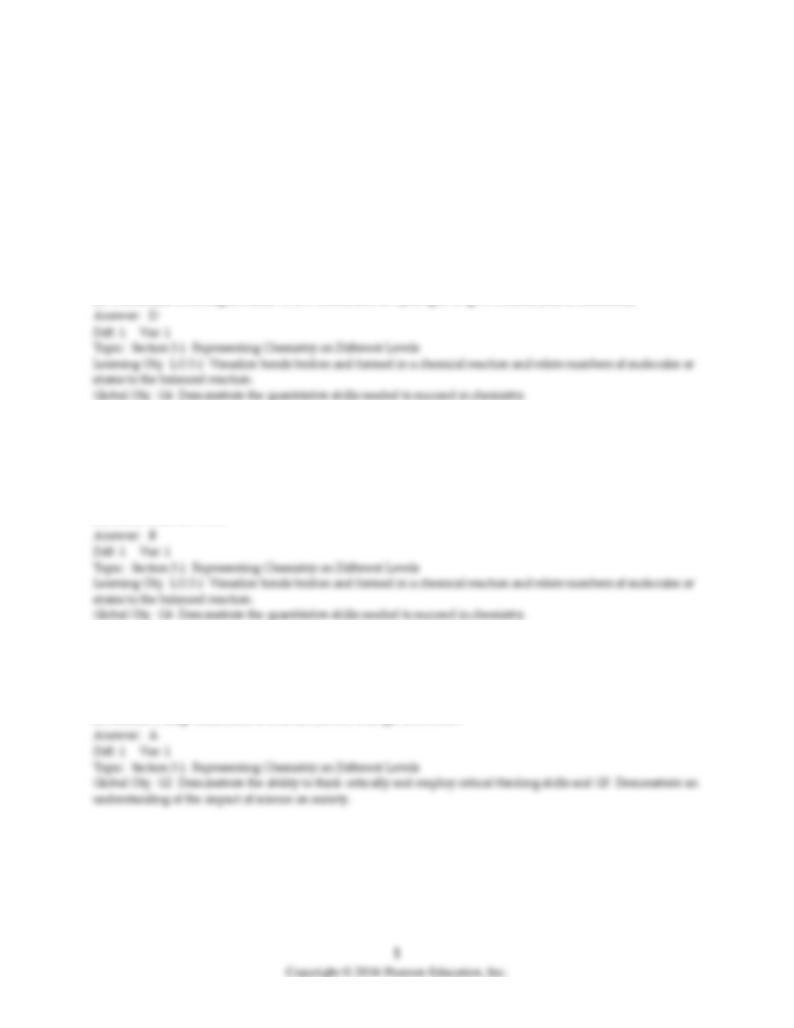
Chemistry, 7e (McMurry/Fay)
Chapter 3 Mass Relationships in Chemical Reactions
3.1 Multiple-Choice Questions
1) Given the chemical equation: N2 + 3 H2 → 2 NH3. On a molecular level, what do the coefficients
mean?
A) 1 atom of nitrogen reacts with 3 atoms of hydrogen to give 2 atoms of ammonia.
B) 28 g of nitrogen reacts with 6 grams of hydrogen to give 34 grams of ammonia.
C) 1 mole of nitrogen reacts with 3 moles of hydrogen to give 2 moles of ammonia.
D) 1 molecule of nitrogen reacts with 3 molecules of hydrogen to give 2 molecules of ammonia.
2) Given the chemical equation: N2 + 3 H2 → 2 NH3. On a macroscopic level, what do the coefficients
mean?
A) 1 atom of nitrogen reacts with 3 atoms of hydrogen to give 2 atoms of ammonia.
B) 1 mole of nitrogen reacts with 3 moles of hydrogen to give 2 moles of ammonia.
C) 1 molecule of nitrogen reacts with 3 molecules of hydrogen to give 2 molecules of ammonia.
D) All of these are true.
3) Which conducts electricity?
A) a large collection of iron atoms
B) a single iron atom
C) both a large collection of iron atoms and a single iron atom
D) neither a large collection of iron atoms nor a single iron atom
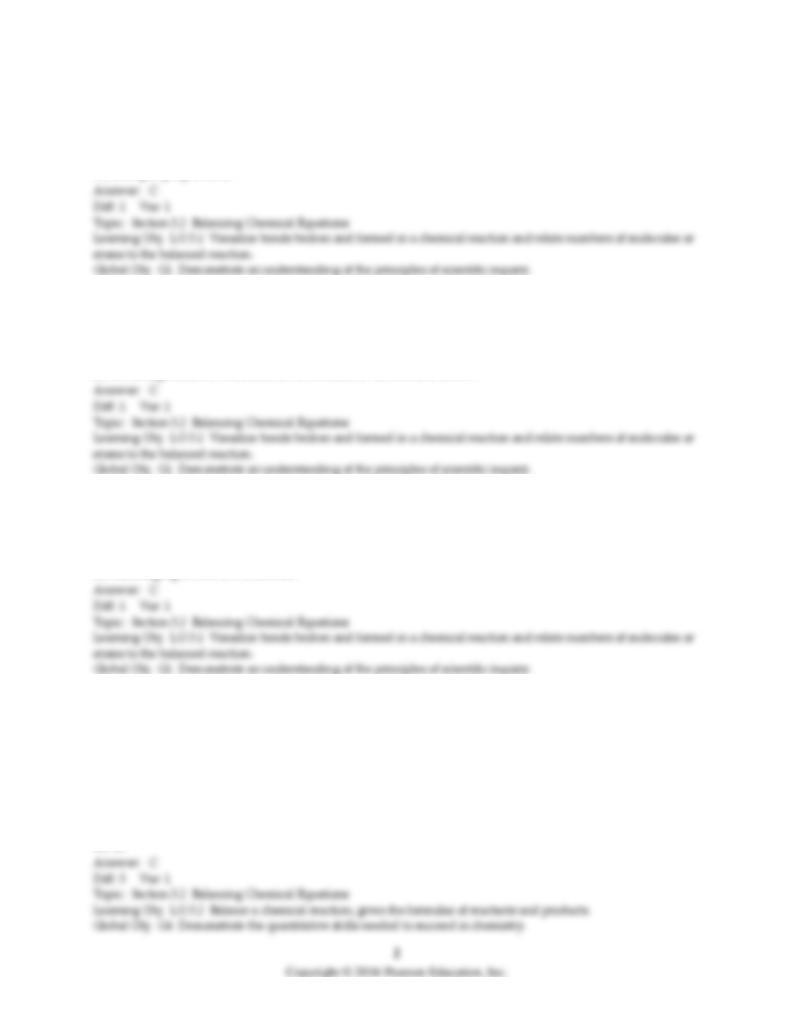
4) Chemical equations are balanced in order to obey the law of
A) definite proportions.
B) mass action.
C) mass conservation.
D) multiple proportions.
5) Which one of the following statements about balanced equations is false? In a balanced reaction
A) atoms must be balanced on both sides of the reaction arrow.
B) mass must be conserved.
C) molecules must be balanced on both sides of the reaction arrow.
D) net charge must be balanced on both sides of the reaction arrow.
6) Which one of the following statements about balanced equations is true? A reaction is balanced by
A) changing the charge on an ion.
B) changing the formula of the molecule.
C) multiplying by suitable coefficients.
D) rearranging atoms in a molecule.
7) What is the sum of the coefficients when the following equation is balanced using the lowest whole-
numbered coefficients?
________ PH3(g) + ________ O2(g) → ________ P4O10(s) + ________ H2O(g)
A) 10
B) 12
C) 19
D) 22
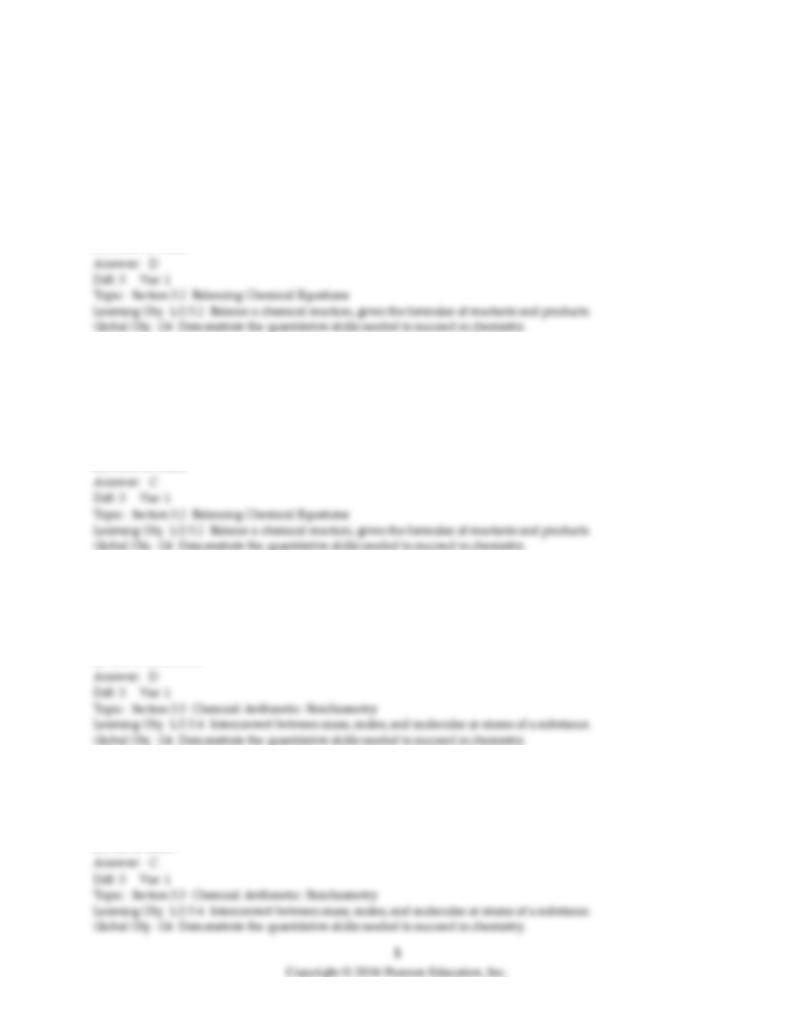
8) What is the sum of the coefficients when the following equation is balanced using the lowest whole-
numbered coefficients?
________ B2O3(s) + ________ HF(l) → ________ BF3(g) + ________ H2O(l)
A) 8
B) 11
C) 15
D) none of these
9) Sodium phosphate reacts with sulfuric acid to form sodium sulfate and phosphoric acid. What is the
stoichiometric coefficient for sulfuric acid when the chemical equation is balanced using the lowest
whole-number stoichiometric coefficients?
A) 1
B) 2
C) 3
D) none of these
10) 1.00 mole of O2 contains the same number of oxygen atoms as
A) 0.667 mole of O3.
B) 1.00 mole of CH3CO2H.
C) 2.00 mole of CH3CH2OH.
D) All of the above
11) Which contains Avogadro's number of formula units?
A) 36.5 g of Cl
B) 36.5 g of Cl2
C) 36.5 g of HCl
D) All of these
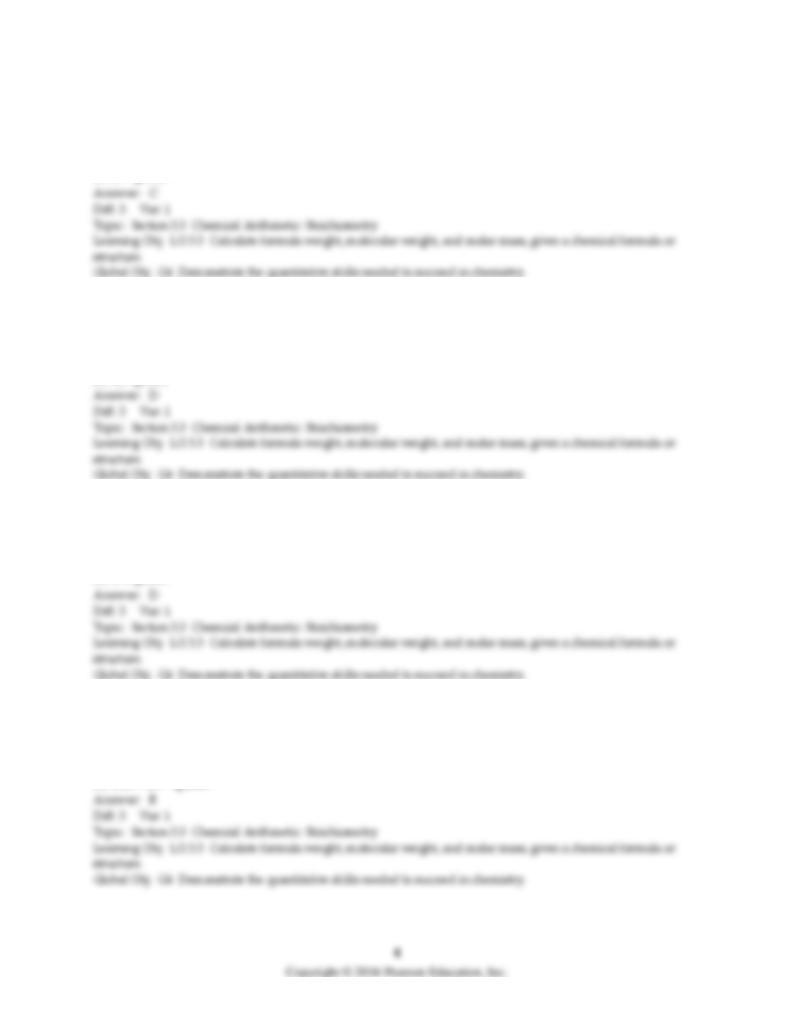
12) What is the molar mass of aspartic acid, C4O4H7N?
A) 43 g/mol
B) 70 g/mol
C) 133 g/mol
D) 197 g/mol
13) What is the molar mass of Co(NO3)2?
A) 90 g/mol
B) 121 g/mol
C) 152 g/mol
D) 183 g/mol
14) What is the molar mass of calcium permanganate?
A) 159 g/mol
B) 199 g/mol
C) 216 g/mol
D) 278 g/mol
15) What is the molar mass of iodine?
A) 126.9 g/mol
B) 253.8 g/mol
C) 6.02 × 1023 g/mol
D) 1.20 × 1024 g/mol
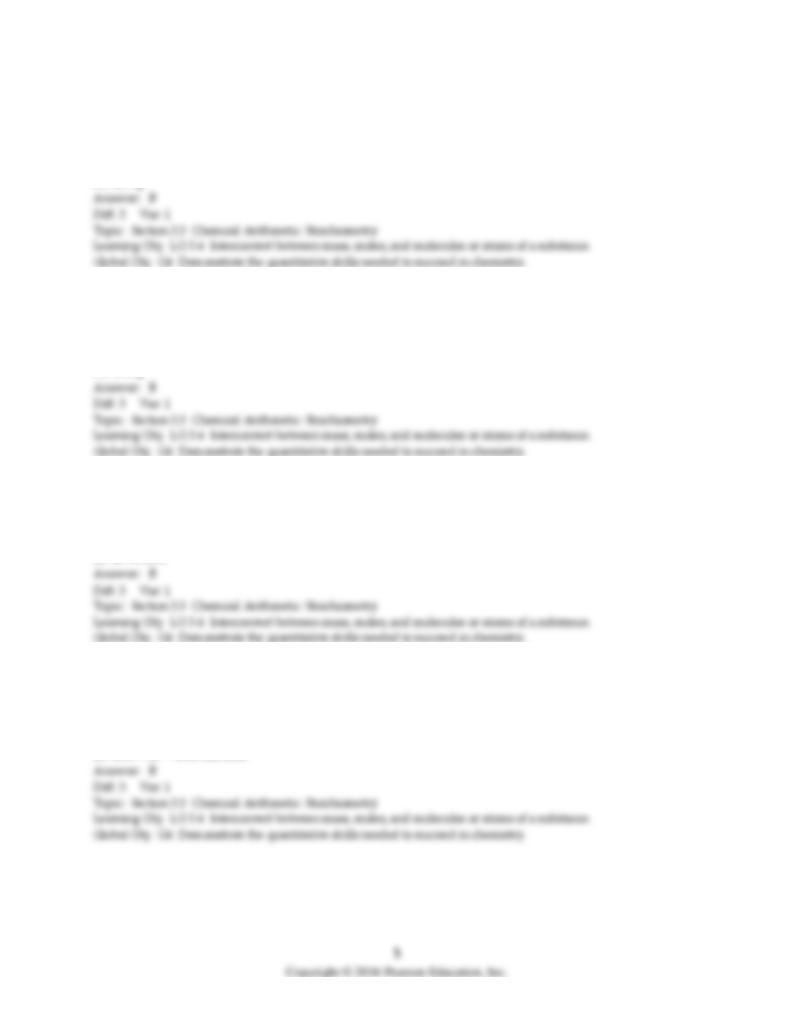
16) What is the mass of a single ozone molecule, O3?
A) 2.656 × 10-23 g
B) 7.969 × 10-22 g
C) 16.0 g
D) 48.0 g
17) What is the mass of 0.0500 mol of dichlorodifluoromethane, CF2Cl2?
A) 4.14 × 10-4 g
B) 6.05 g
C) 12.1 g
D) 24.2 g
18) How many moles are in 1.50 g of ethylamine, CH3CH2NH2?
A) 0.0222 mol
B) 0.0332 mol
C) 90.16 mol
D) 45.08 mol
19) How many sulfate ions are there in 5.00 g of FeSO4?
A) 5.46 × 10-26 iron (II) ions
B) 1.98 × 1022 iron (II) ions
C) 1.83 × 1025 iron (II) ions
D) 4.58 × 1026 iron (II) ions
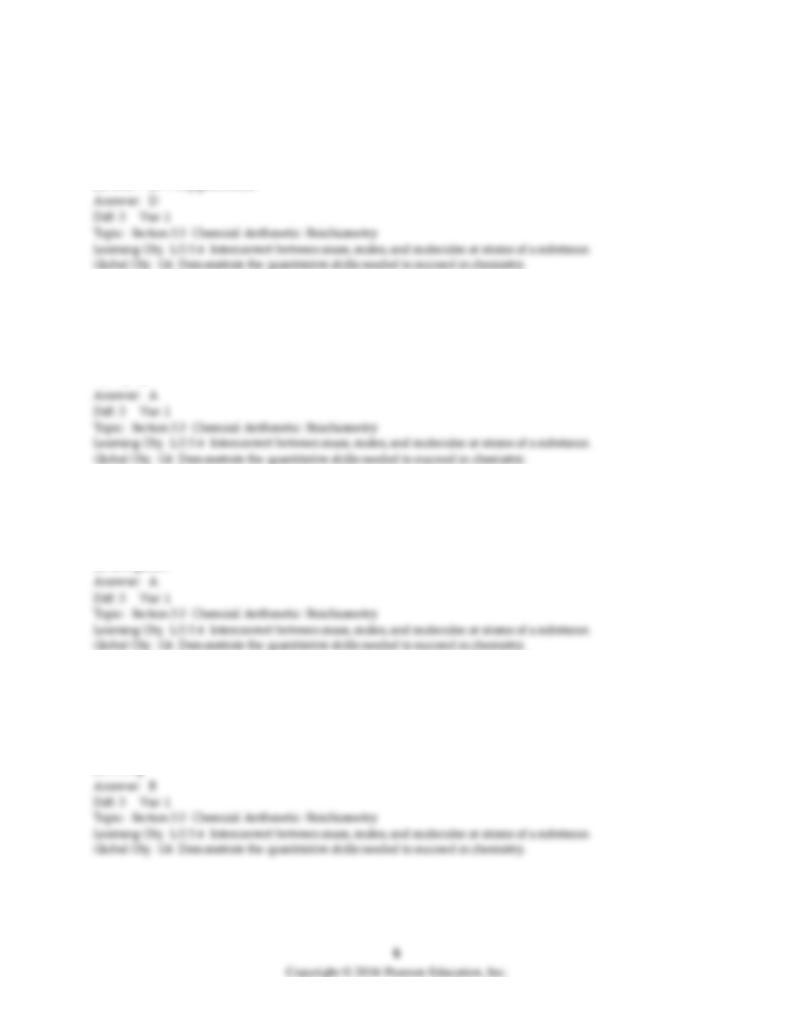
20) How many sodium atoms are in 3.00 g of sodium dichromate, Na2Cr2O7?
A) 0.023 oxygen atoms
B) 2.82 × 1020 oxygen atoms
C) 1.97 × 1021 oxygen atoms
D) 1.38 × 1022 oxygen atoms
21) What is the identity of substance X if 0.380 mol of X weighs 17.5 g?
A) NO2
B) NO3
C) N2O
D) N2O4
22) What is the molar mass of aspirin if 5.19 × 1016 molecules of aspirin weigh 15.53 μg?
A) 180 g/mol
B) 80.6 g/mol
C) 133.8 g/mol
D) 200 g/mol
23) What mass of carbon monoxide, CO, contains the same number of molecules as 3.00 g of
trichlorofluoromethane, CCl3F?
A) 3.00 g
B) 0.612 g
C) 1.63 g
D) 9.33 g

24) What mass of sulfur hexafluoride, SF6, has the same number of fluorine atoms as 50.0 g of oxygen
difluoride, OF2?
A) 202.7 g
B) 8.33 g
C) 43.0 g
D) 135.1 g
25) How many cations are in 0.500 g of MgBr2?
A) 1.37 × 1021 anions
B) 1.64 × 1021 anions
C) 2.22 × 1026 anions
D) 4.43 × 1026 anions
26) How many anions are in 10.0 g of sodium phosphate?
A) 3.67 × 1022 cations
B) 1.10 × 1023 cations
C) 9.87 × 1024 cations
D) 2.96 × 1025 cations
27) Which of the following has the greatest mass?
A) 6.0 × 1023 atoms of O
B) 3.0 × 1023 molecules of O2
C) 2.0 × 1023 molecules of O3
D) All have the same mass.
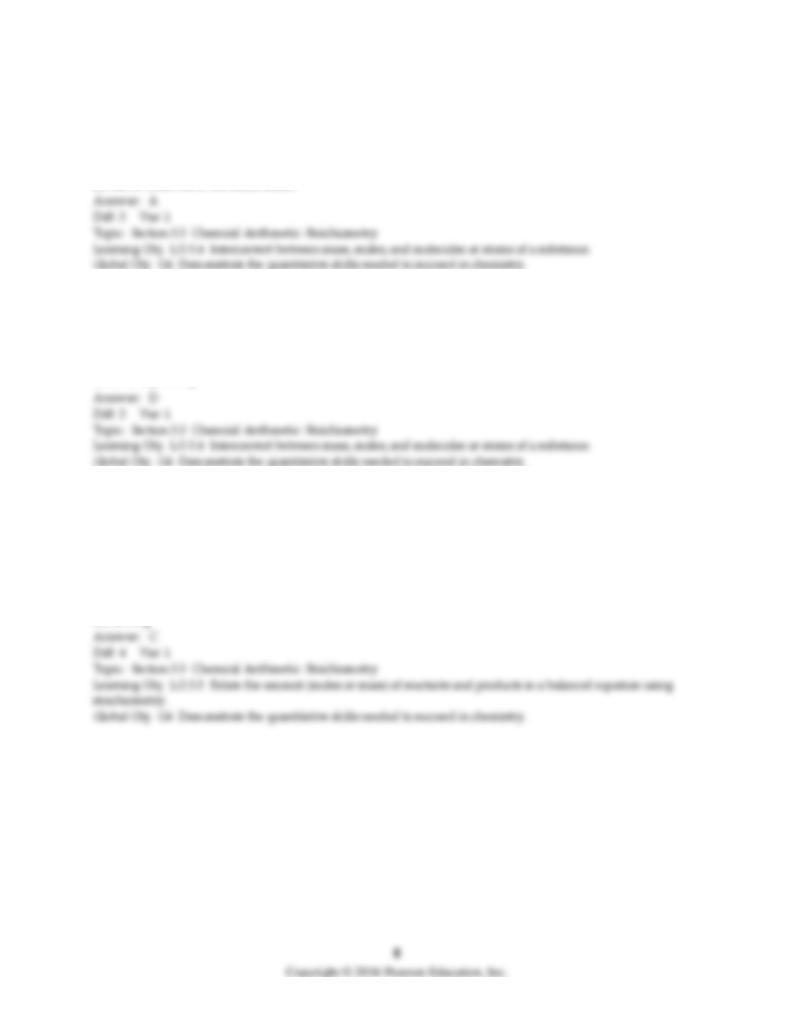
28) Which of the following has the greatest mass?
A) 6.02 × 1023 molecules of Cl2
B) 35.45 g of Cl2
C) 0.500 mol of Cl2
D) All of these have the same mass.
29) Which of the following has the smallest mass?
A) 6.02 × 1023 molecules of I2
B) 70.0 g of Cl2
C) 2.00 mol of F2
D) 0.040 kg of Br2
30) How many grams of calcium chloride are needed to produce 10.0 g of potassium chloride?
CaCl2(aq) + K2CO3(aq) → 2 KCl(aq) + CaCO3(aq)
A) 0.134 g
B) 7.44 g
C) 9.28 g
D) 18.56 g
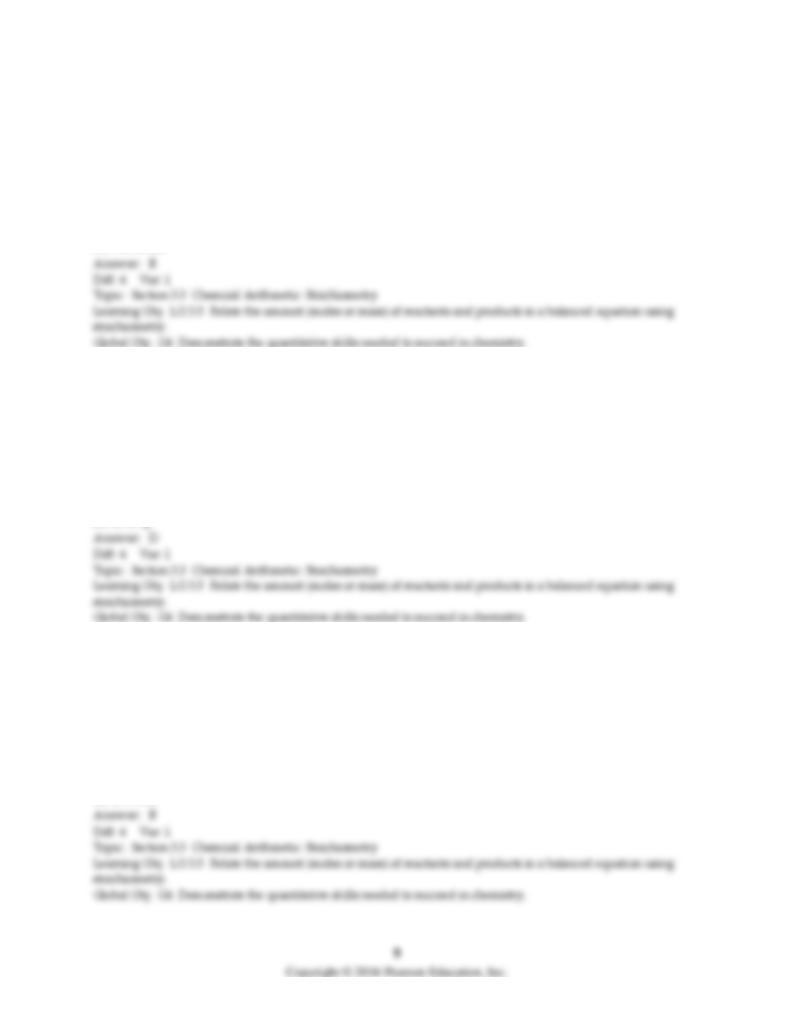
31) Balance the chemical equation given below, and determine the number of moles of iodine that reacts
with 5.0 g of aluminum.
________ Al(s) + ________ I2(s) → ________ Al2I6(s)
A) 0.185 mol
B) 0.278 mol
C) 0.139 mol
D) 0.834 mol
32) Balance the chemical equation given below, and determine the number of grams of Fe needed to
produce 15.0 g of Fe2O3.
________ MgO(s) + ________ Fe(s) → ________ Fe2O3(s) + ________ Mg(s)
A) 11.36 g
B) 3.78 g
C) 5.245 g
D) 10.49 g
33) The density of ethanol, C2H5OH, is 0.789 g/mL. How many milliliters of ethanol are needed to
produce 5.00 g of CO2 according to the following chemical equation?
C2H5OH(l) + 3 O2(g) → 2 CO2(g) + 3 H2O(l)
A) 2.06 mL
B) 3.32 mL
C) 6.60 mL
D) 13.3 mL
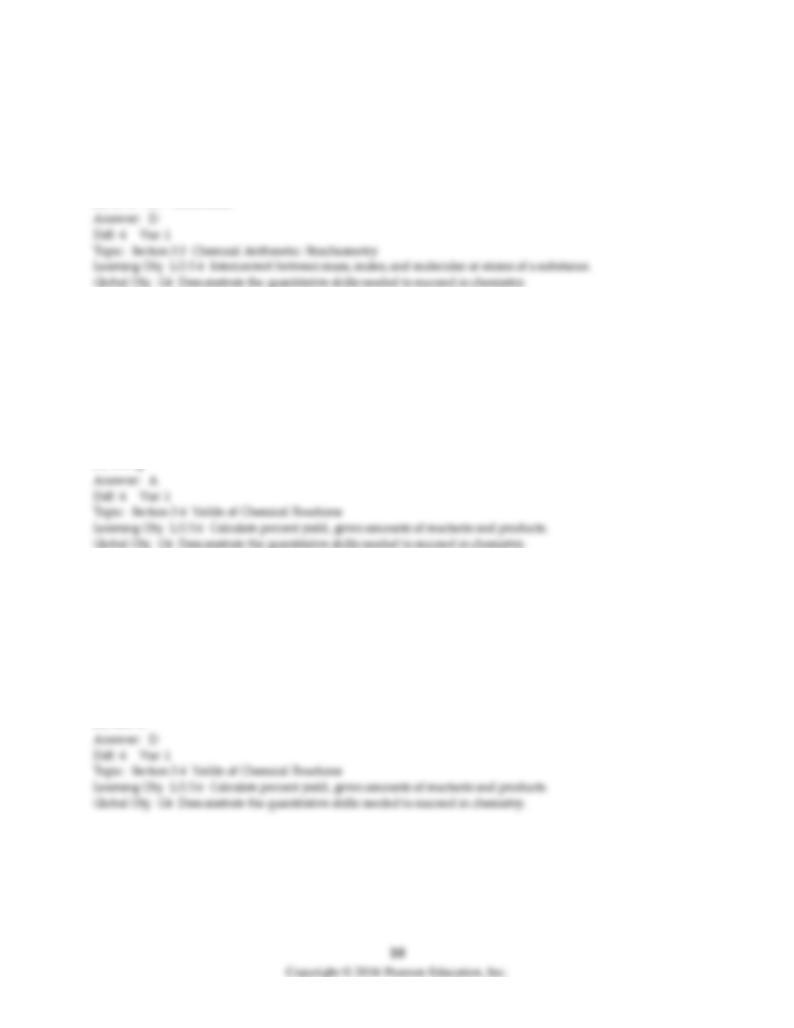
34) Tablets of ascorbic acid, or Vitamin C, C6H8O6, are taken as a dietary supplement. If a typical tablet
contains 500 mg, how many molecules of Vitamin C are in a tablet?
A) 500 molecules
B) 1.71 × 1024 molecules
C) 3.0 × 1024 molecules
D) 1.71 × 1021 molecules
35) If the percent yield for the following reaction is 60.0%, and 45.0 g of NO2 are consumed in the
reaction, how many grams of nitric acid, HNO3(aq), are produced?
3 NO2(g) + H2O(l) → 2 HNO3(aq) + NO(g)
A) 24.6 g
B) 41.1 g
C) 54.8 g
D) 69.3 g
36) In the reaction between glucose and oxygen, 10.0 g of glucose reacts and 7.50 L of carbon dioxide is
formed. What is the percent yield if the density of CO2 is 1.26 g/L?
C6H12O6(s) + 6 O2(g) → 6 CO2(g) + 6 H2O(l)
A) 26.1%
B) 40.6%
C) 43.1%
D) 64.5%
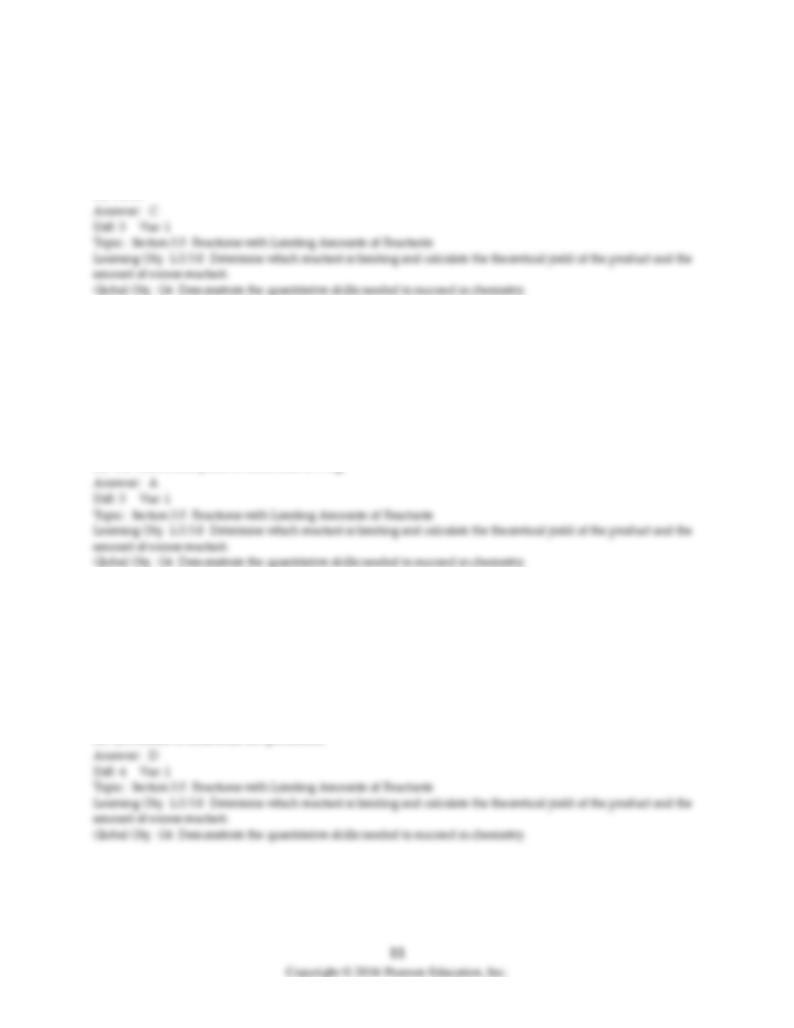
37) When methane, CH4, undergoes combustion with oxygen, the usual products are carbon dioxide and
water. Carbon monoxide is formed when the limiting reactant is
A) carbon dioxide.
B) methane.
C) oxygen.
D) water.
38) 5.0 g of nitrogen is reacted with 5.0 g of hydrogen to produce ammonia according to the chemical
equation shown below. Which one of the following statements is false?
N2(g) + 3 H2(g) → 2 NH3(g)
A) 2.8 grams of hydrogen are left over.
B) Hydrogen is the excess reactant.
C) Nitrogen is the limiting reactant.
D) The theoretical yield of ammonia is 6.1 g.
39) 3.0 moles of nitrogen is reacted with 11.0 moles of hydrogen to produce ammonia according to the
chemical equation shown below. Which one of the following statements is false?
N2(g) + 3 H2(g) → 2 NH3(g)
A) 2.0 moles of hydrogen are left over.
B) Hydrogen is the excess reactant.
C) Nitrogen is the limiting reactant.
D) 12.0 moles of ammonia are produced.
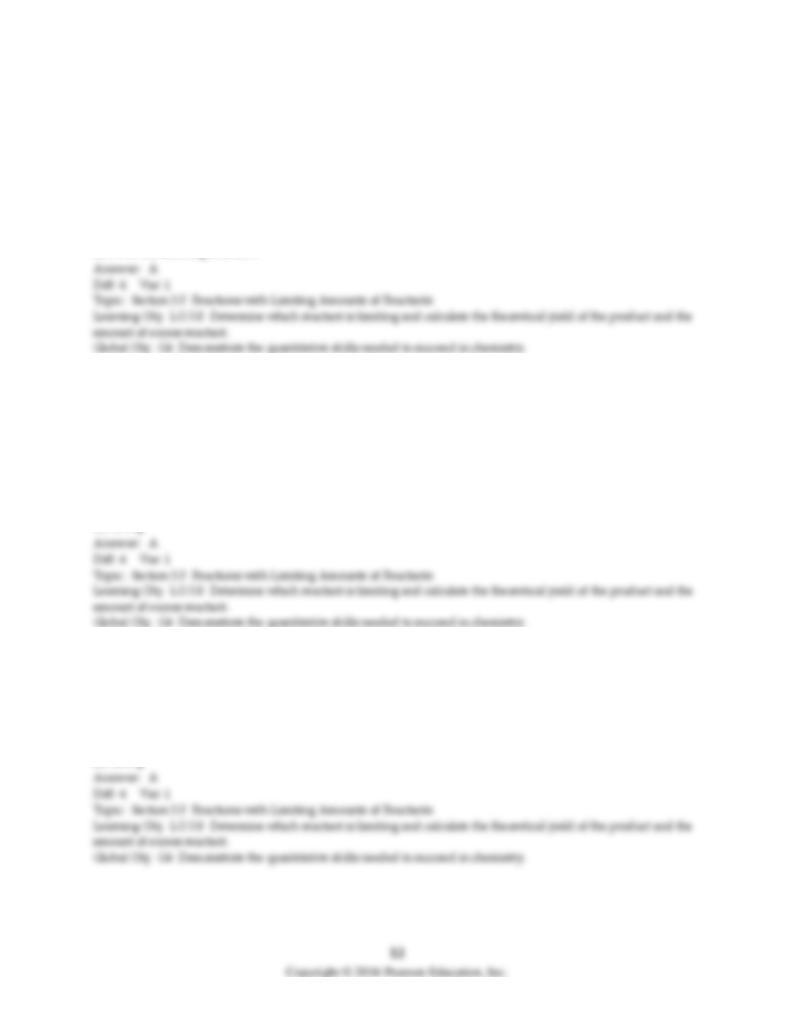
40) 4.0 g of iron is reacted with 4.0 g of water according to the chemical equation shown below. Which
one of the following statements is false?
3 Fe(s) + 4 H2O(l) → Fe3O4(s) + 4 H2(g)
A) 6.91 g of Fe3O4 are produced.
B) 2.28 g of H2O are left over.
C) Mass is conserved in this reaction.
D) Fe is the limiting reactant.
41) How many grams of the excess reagent are left over when 6.00 g of CS2 gas react with 10.0 g of Cl2
gas in the following reaction?
CS2(g) + 3 Cl2(g) → CCl4(l) + S2Cl2(l)
A) 2.42 g
B) 2.77 g
C) 3.58 g
D) 4.00 g
42) When silver nitrate reacts with barium chloride, silver chloride and barium nitrate are formed. How
many grams of silver chloride are formed when 8.0 g of silver nitrate reacts with 15.0 g of barium
chloride?
A) 6.752 g
B) 9.40 g
C) 11.9 g
D) 18.8 g
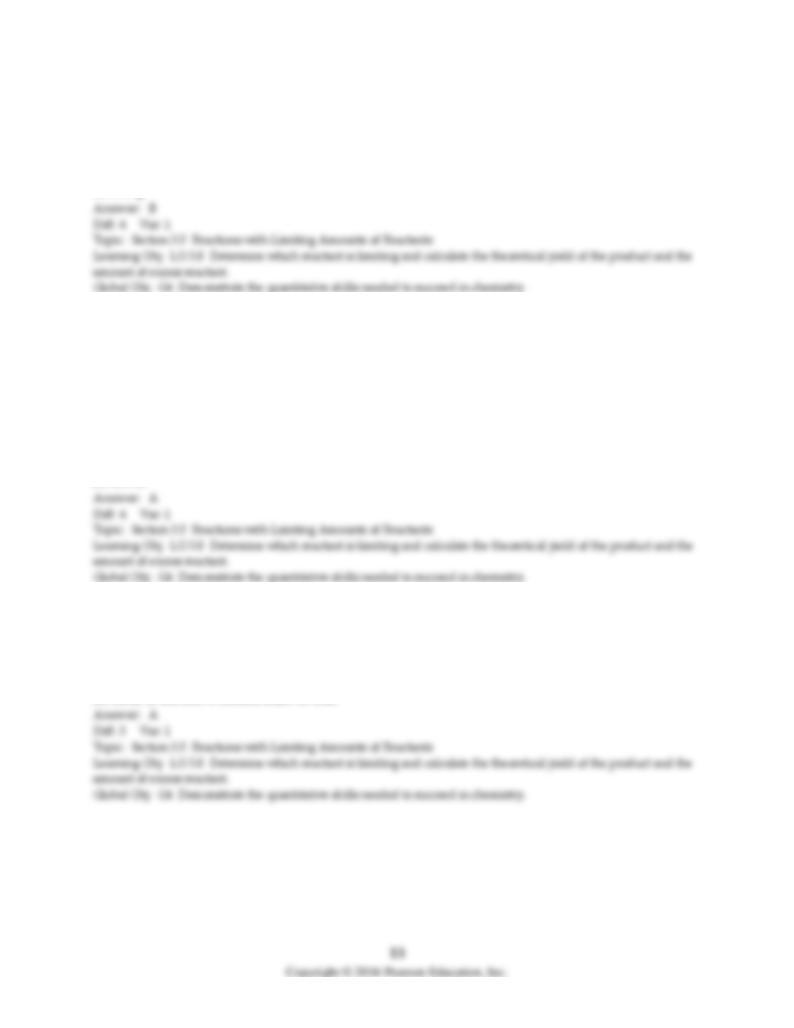
43) When iron(III) oxide reacts with hydrochloric acid, iron(III) chloride and water are formed. How
many grams of iron(III) chloride are formed from 10.0 g of iron(III) oxide and 10.0 g of hydrochloric acid?
A) 11.1 g
B) 14.8 g
C) 20.3 g
D) 35.1 g
44) Balance the chemical equation given below, and calculate the volume of nitrogen monoxide gas
produced when 8.00 g of ammonia is reacted with 14.0 g of oxygen at 25°C? The density of nitrogen
monoxide at 25°C is 1.23 g/L.
________ NH3(g) + ________ O2(g) → ________ NO(g) + ________ H2O(l)
A) 8.54 L
B) 11.1 L
C) 11.5 L
D) 18.8 L
45) Consider two reactants, A and B. The molar mass of A is greater han the molar mass of B. You add
equal masses of A and B together and let them react. Which of the following statements must be true?
A) Reactant A must be limiting.
B) Reactant B must be limiting.
C) Reactant A is the excess reactant.
D) None of the above choices must be true.
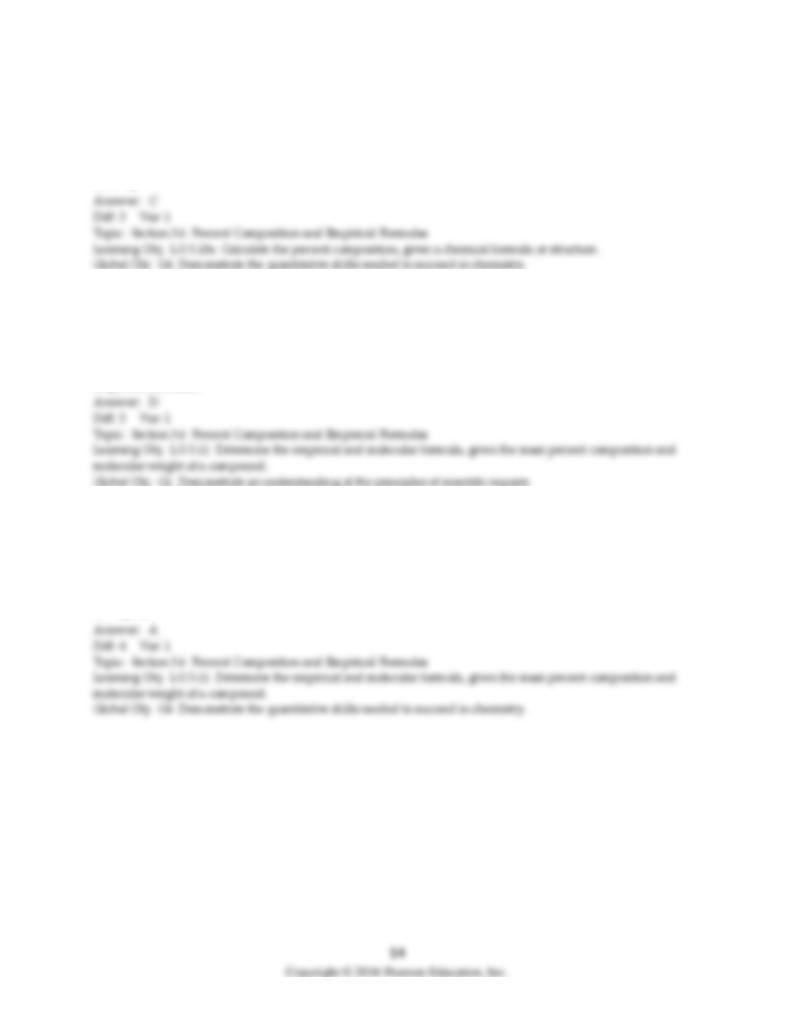
46) Which one of the following contains 38.7% carbon by mass?
A) C2H2
B) CH4
C) CH3NH2
D) CO2
47) Which of the following statements is false concerning the formula of a compound?
A) The empirical formula is the simplest whole numbered ratio of atoms in a compound.
B) The molecular formula is the true ratio of atoms in a compound.
C) The molecular formula and empirical formula can be identical.
D) The number of atoms in a molecular formula is always greater than the number of atoms in an
empirical formula.
48) What is the empirical formula for ethyl fluoride if the compound contains 49.97% carbon, 10.51%
hydrogen, and 39.52% fluorine by mass?
A) C2H5F
B) C4H10F2
C) C4H10F4
D) C25F2
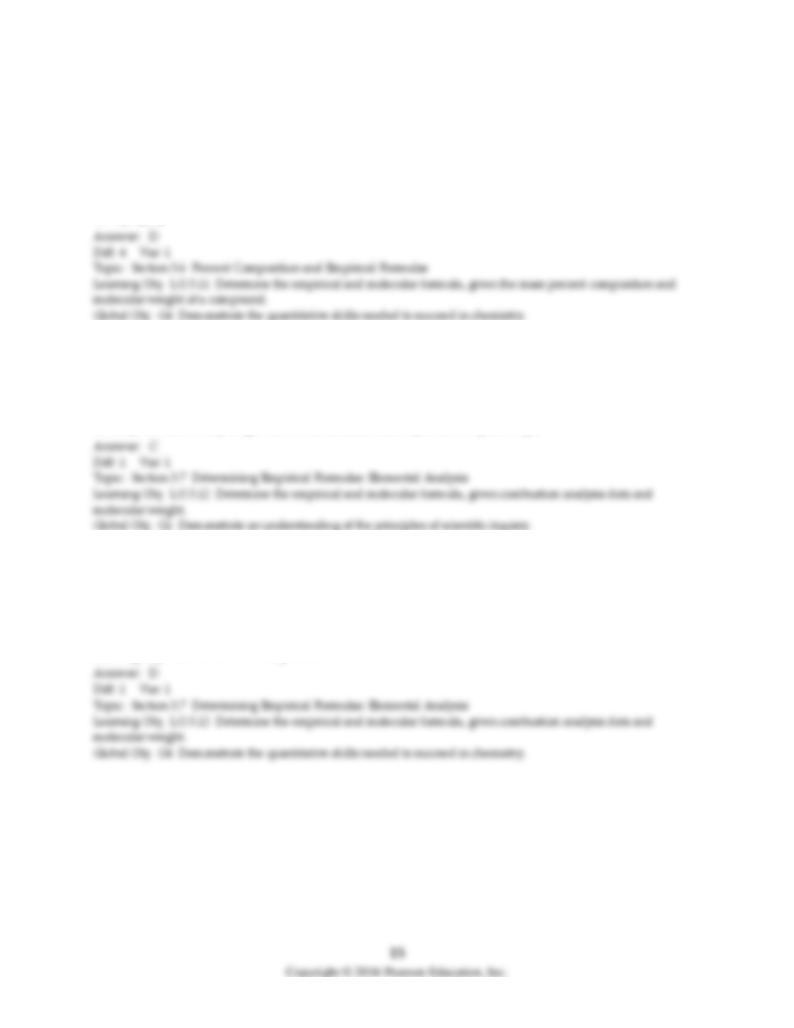
49) A compound responsible for the odor of garlic has a molecular weight of 146 g/mol. A 0.650 g sample
of the compound contains 0.321 g of carbon, 0.044 g of hydrogen, and 0.285 g of sulfur. What is the
molecular formula of the compound?
A) CH5S
B) C3H5S
C) C3H15S3
D) C6H10S2
50) Which statement about elemental analysis by combustion is not correct?
A) Carbon is determined from the amount of CO2 formed.
B) Hydrogen is determined from the amount of H2O formed.
C) Oxygen is determined from the amount of H2O formed.
D) Only carbon and hydrogen can be determined directly from CO2 and H2O.
51) In the combustion analysis of an unknown compound containing only carbon, hydrogen, and oxygen,
the grams of oxygen are found from the grams of
A) CO2 only.
B) H2O only.
C) CO2 and H2O only.
D) CO2, H2O and unknown compound.
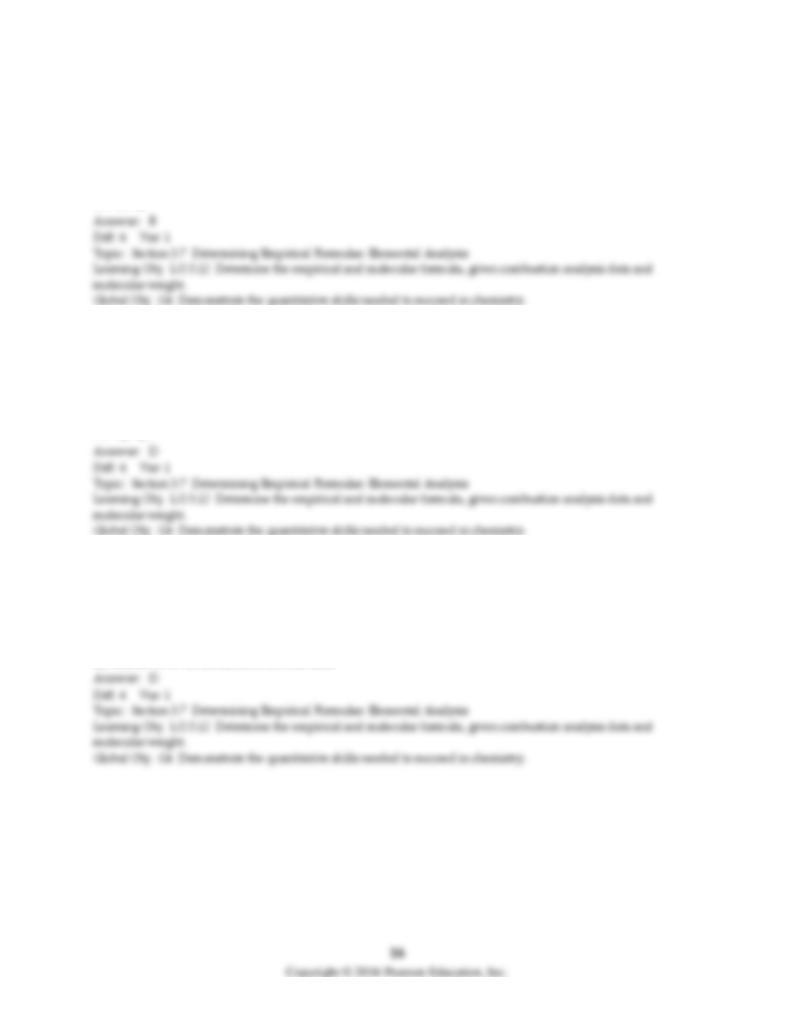
52) Combustion analysis of an unknown compound containing only carbon and hydrogen produced
2.845 g of CO2 and 1.744 g of H2O. What is the empirical formula of the compound?
A) CH2
B) CH3
C) C4H10
D) C5H2
53) Combustion analysis of 2.796 g of an unknown compound containing carbon, hydrogen, and oxygen
produced 5.597 g of CO2 and 2.268 g of H2O. What is the empirical formula of the compound?
A) C2H5O
B) C2H5O2
C) C2H10O3
D) C2H4O
54) Combustion analysis of a 0.675 g sample of an unknown compound that contains only carbon,
hydrogen, and oxygen gives 0.627 g of CO2 and 1.534 g of H2O. The molecular mass of the unknown is
A) C3H6O.
B) C6H12O2.
C) C9H18O3.
D) unable to be determined from this data.
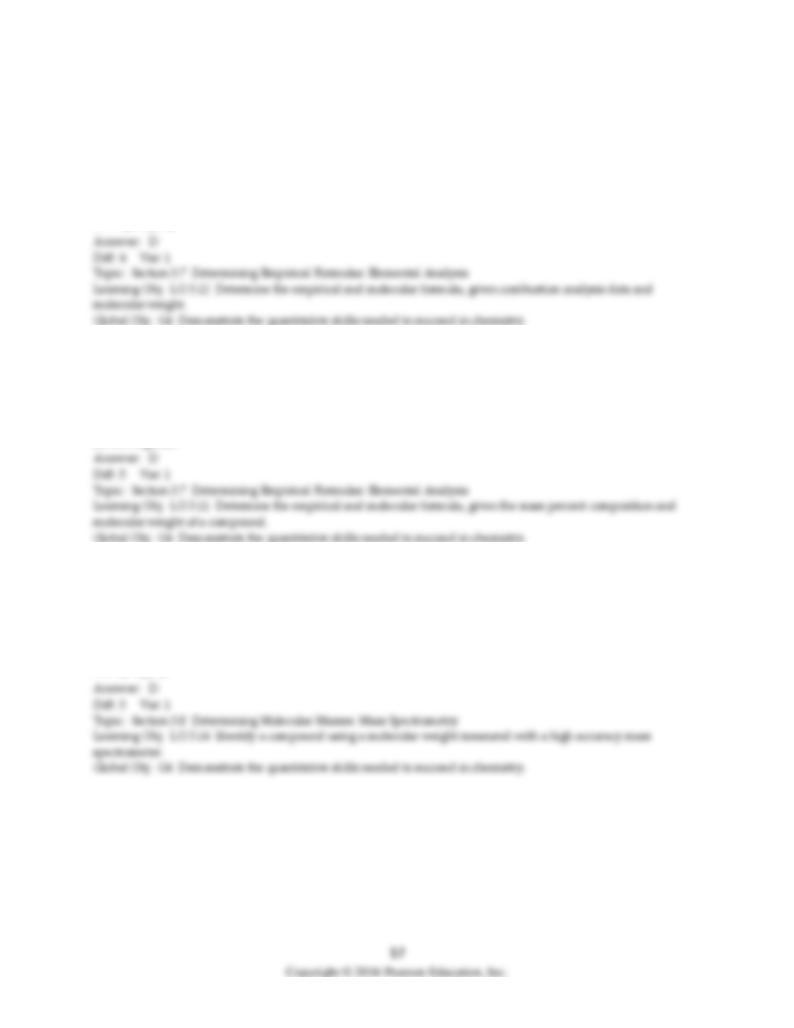
55) Isoeugenol is the compound which gives the characteristic odor to nutmeg and contains carbon,
hydrogen, and oxygen. If a 0.500 g sample of isoeugenol is combusted it gives 1.341 g of CO2 and 0.329 g
of H2O. Isoeugenol has a molecular weight of 164 g/mol. What is the molecular formula of isoeugenol?
A) C2HO
B) C5H6O
C) C8H4O4
D) C10H12O2
56) Each molecule of cortisone contains 21 atoms of carbon (plus other atoms). The mass percentage of
carbon in cortisone is 69.98%. What is the molar mass of cortisone?
A) 176.5 g/mol
B) 252.2 g/mol
C) 287.6 g/mol
D) 360.4 g/mol
57) The sugar fructose has an empirical formula of CH2O. The mass spectrum shows a molecular ion
peak at a mass of 179.9. What is the molecular formula of fructose?
A) CH2O
B) C2H4O4
C) C6H11O6
D) C6H12O6
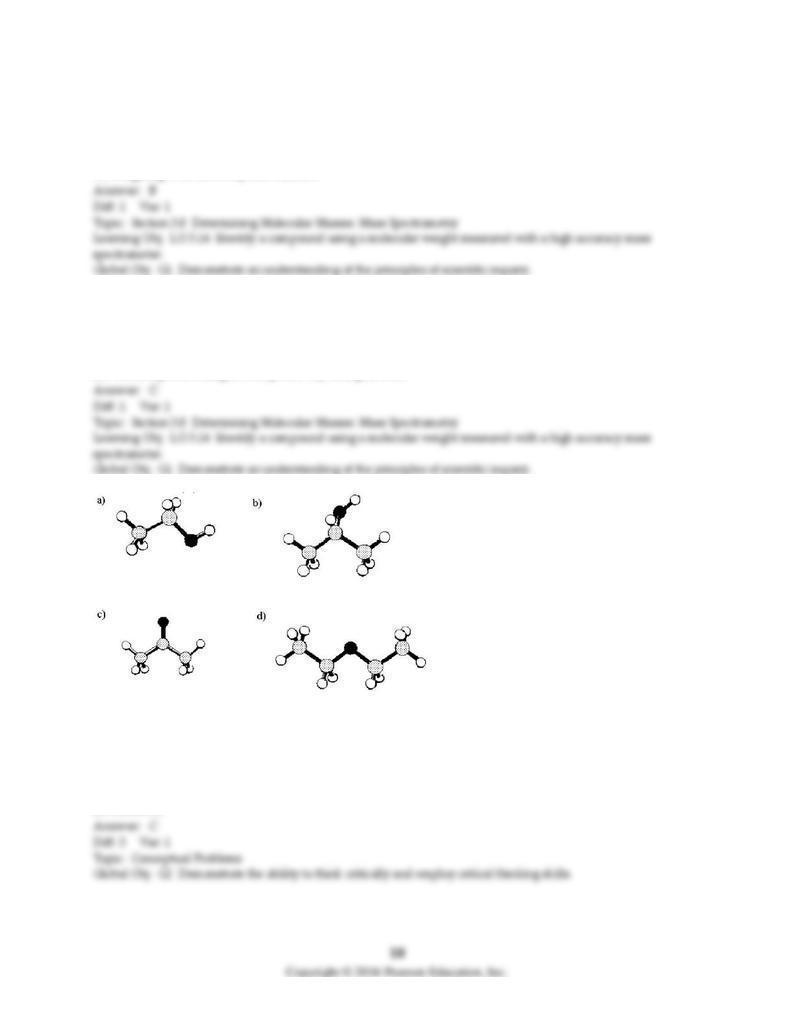
58) Molecular mass can be determined by
A) combustion analysis.
B) mass spectrometry.
C) titration.
D) weighing with an analytical balance.
59) Which of the following statements about mass spectrometry is false?
A) Mass spectrometry can be used to determine the molecular weight of a compound.
B) The curvature of the path in a magnetic field is determined by the mass of the ion.
C) The paths of heavier ions are deflected more strongly than the paths of lighter ions.
D) The sample is changed into positively charged ions.
60) Acetone has the formula C3H6O. Which ball and stick model shown above represents acetone? [gray
spheres = C, black spheres = O, unshaded spheres = H]
A) model a)
B) model b)
C) model c)
D) model d)
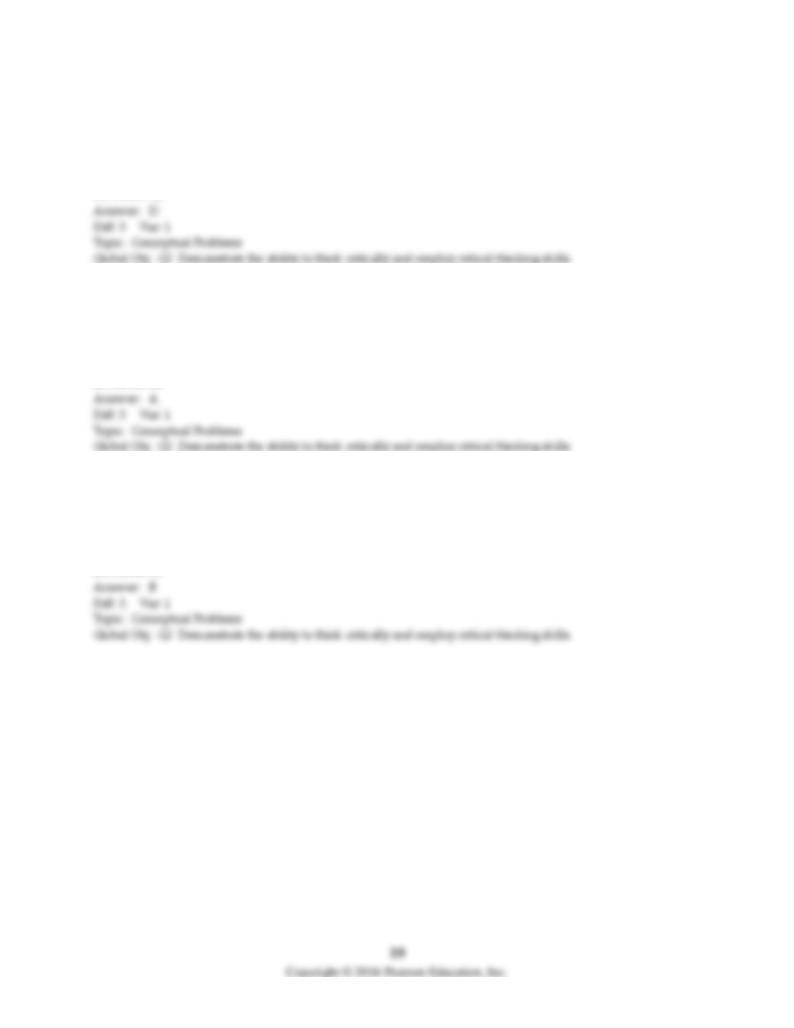
61) Diethyl ether has the molecular formula C4H10O. Which ball and stick model shown above
represents diethyl ether? [gray spheres = C, black spheres = O, unshaded spheres = H]
A) model a)
B) model b)
C) model c)
D) model d)
62) Ethanol has the molecular formula C2H6O. Which ball and stick model shown above represents
ethanol? [gray spheres = C, black spheres = O, unshaded spheres = H]
A) model a)
B) model b)
C) model c)
D) model d)
63) 2-Propanol has the molecular formula C3H8O. Which ball and stick model shown above represents 2-
propanol? [gray spheres = C, black spheres = O, unshaded spheres = H]
A) model a)
B) model b)
C) model c)
D) model d)
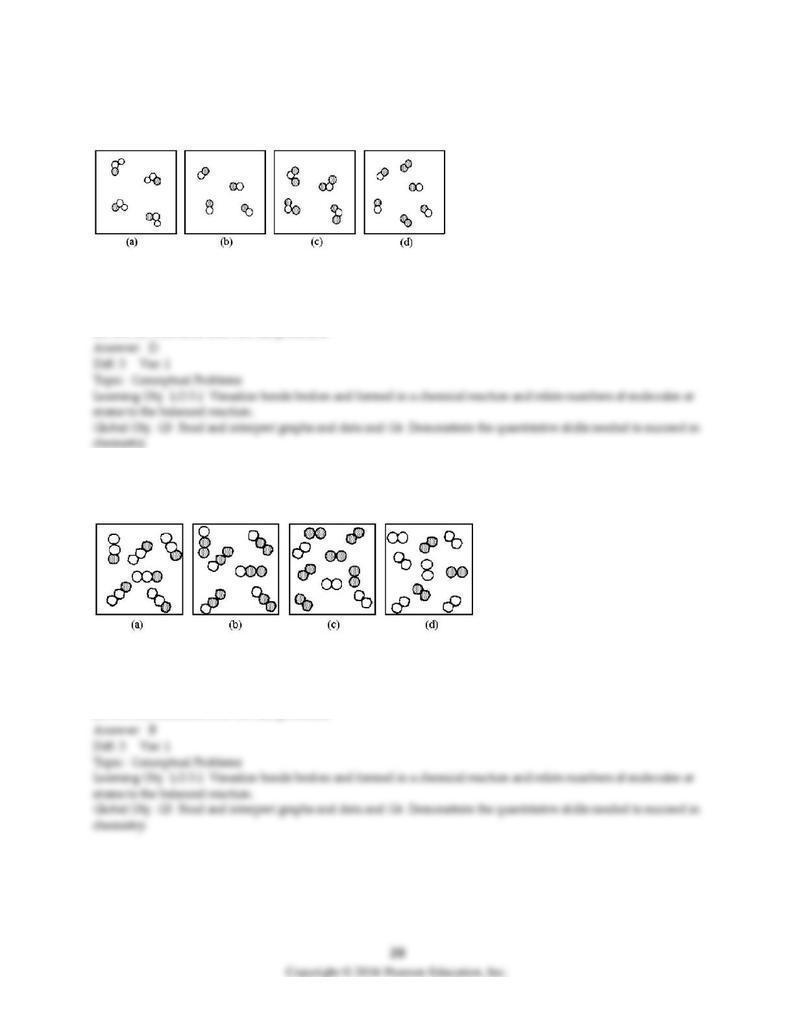
64) If unshaded spheres represent nitrogen atoms and shaded spheres represent oxygen atoms, which
box represents reactants and which represents products for the reaction 2 NO2(g) → 2 NO(g) + O2(g)?
A) box (a) reactants and box (b) products
B) box (a) reactants and box (d) products
C) box (c) reactants and box (b) products
D) box (c) reactants and box (d) products
65) If unshaded spheres represent nitrogen atoms and shaded spheres represent oxygen atoms, which
box represents reactants and which represents products for the reaction 2 N2O(g) → 2 N2(g) + O2(g)?
A) box (a) reactants and box (c) products
B) box (a) reactants and box (d) products
C) box (b) reactants and box (c) products
D) box (b) reactants and box (d) products
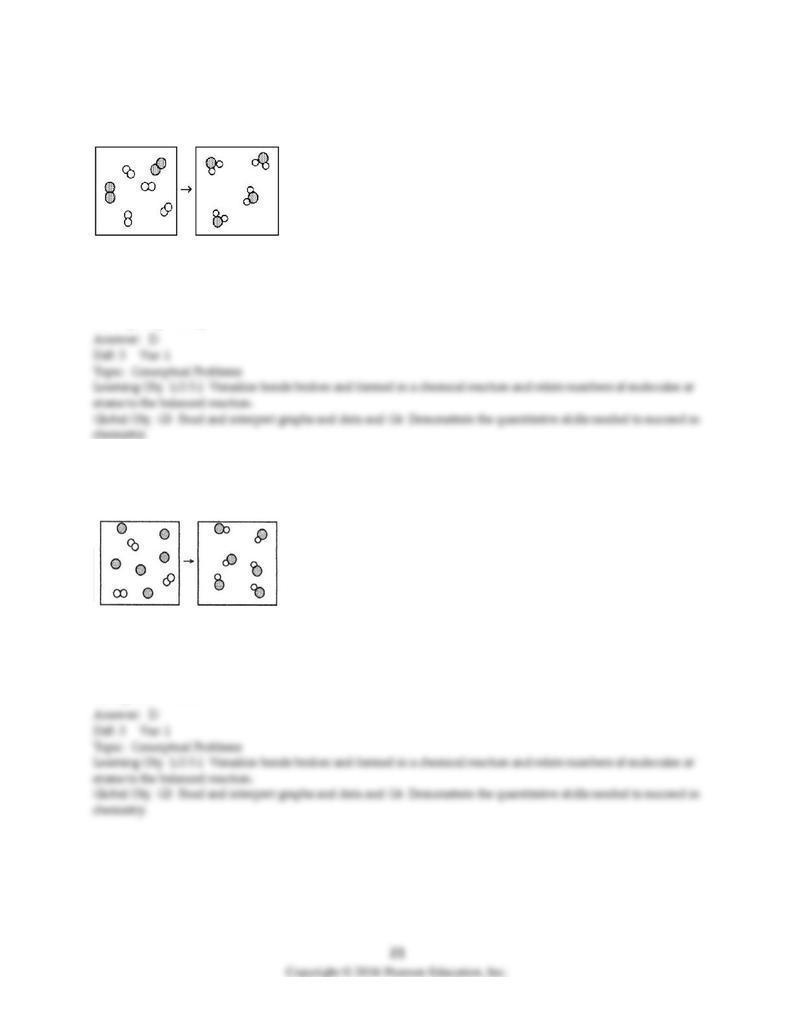
66) What is the balanced chemical equation for the reaction of element A (unshaded spheres) with
element B (shaded spheres) as represented below?
A) A + B → AB
B) 4A + 2B → 4AB
C) A2 + B2 → A2B
D) 2A2 + B2 → 2A2B
67) What is the balanced chemical equation for the reaction of element A (unshaded spheres) with
element B (shaded spheres) as represented below?
A) A + B → AB
B) A + 3B → 3AB
C) A2 + B → AB
D) A2 + 2B → 2AB
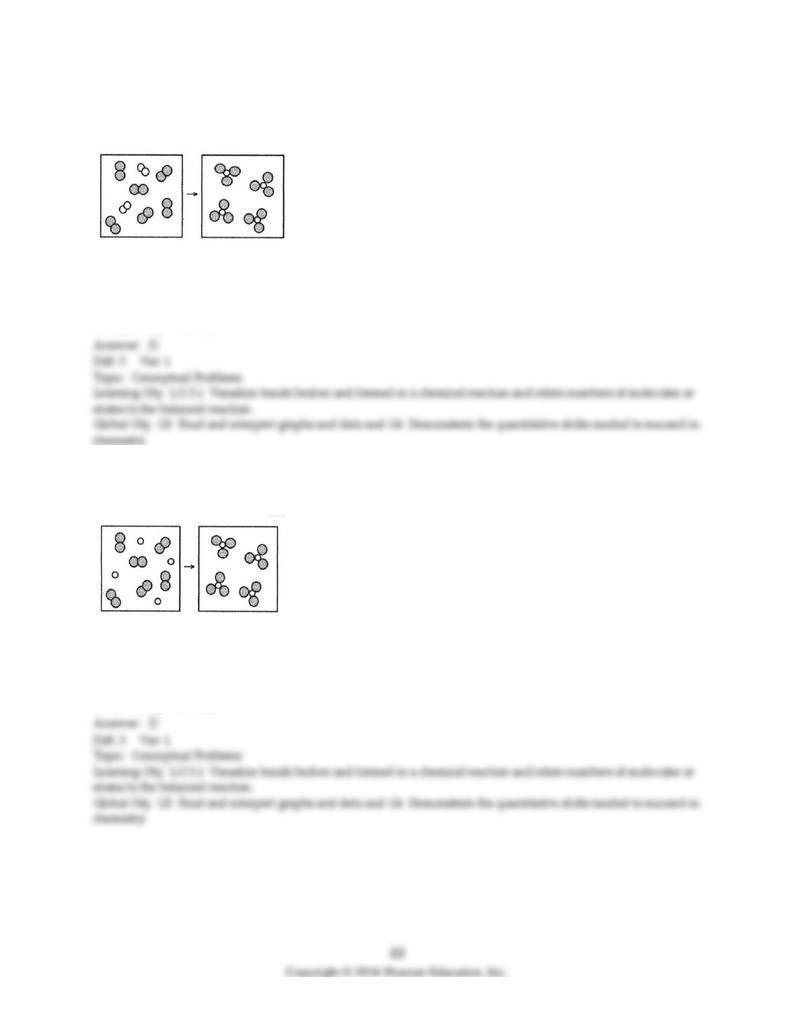
68) What is the balanced chemical equation for the reaction of element A (unshaded spheres) with
element B (shaded spheres) as represented below?
A) A + B → AB
B) A + 3B → 2AB
C) A2 + B2 → AB3
D) A2 + 3B2 → 2AB3
69) What is the balanced chemical equation for the reaction of element A (unshaded spheres) with
element B (shaded spheres) as represented below?
A) A + B → AB
B) 2A + 3B → 2AB
C) A + B2 → AB3
D) 2A + 3B2 → 2AB3
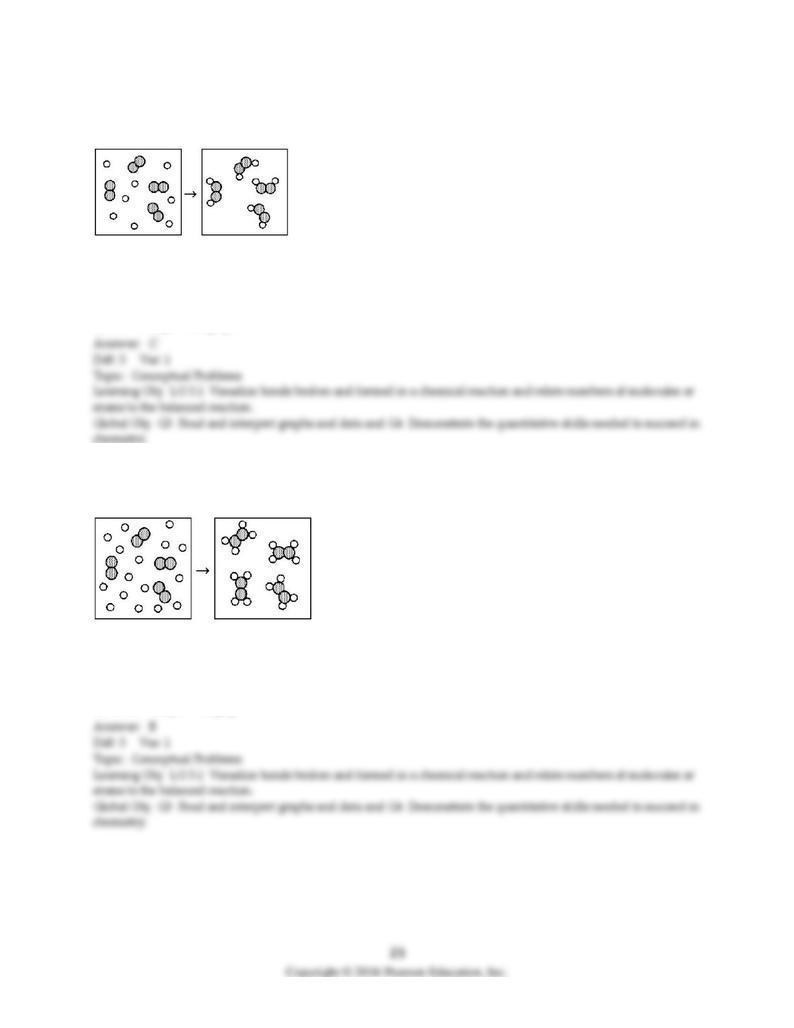
70) Reaction of A (unshaded spheres) with B2 (shaded spheres) is shown schematically in the following
diagram. Which equation best describes the stoichiometry of the reaction?
A) A2 + 2 B → A2B2
B) 8 A + 4 B2 → 4 A2B2
C) 2 A + B2 → A2B2
D) 4 A + 4 B2 → 4 A2B2
71) Reaction of A (unshaded spheres) with B2 (shaded spheres) is shown schematically in the following
diagram. Which equation best describes the stoichiometry of the reaction?
A) 4 A + B2 → 8 A2B
B) 4 A + B2 → A4B2
C) 16 A + 4 B2 → 8 A2B
D) 16 A + 4 B2 → 4 A4B2
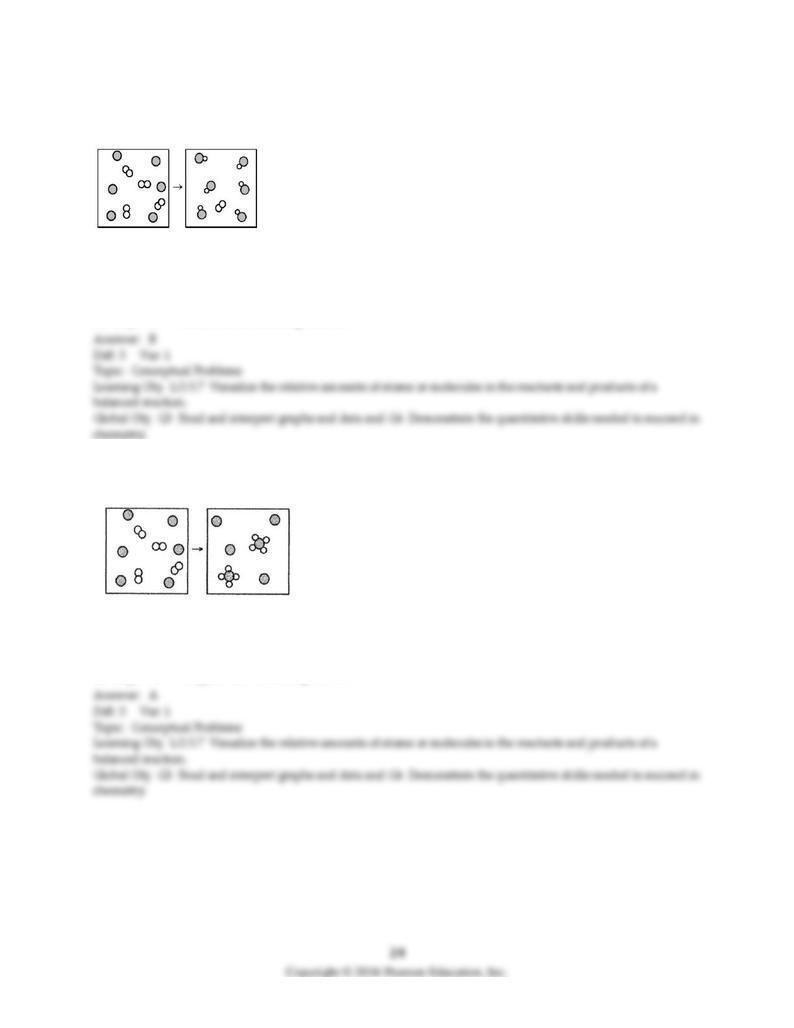
72) The following diagram represents the reaction of A (unshaded spheres) with B (shaded spheres).
What is the balanced chemical equation for this reaction, and what is the limiting reactant?
A) A2 + 2B → 2AB; A2 is the limiting reactant.
B) A2 + 2B → 2AB; B is the limiting reactant.
C) 4A2 + 6B → 6AB; A2 is the limiting reactant.
D) 4A2 + 6B → 6AB; B is the limiting reactant.
73) The following diagram represents the reaction of A2 (unshaded spheres) with B (shaded spheres).
What is the balanced chemical equation for this reaction, and what is the limiting reactant?
A) 2A2 + B → A4B; A2 is the limiting reactant.
B) 2A2 + B → A4B; B is the limiting reactant.
C) 4A2 + 6B → 2A4B; A2 is the limiting reactant.
D) 4A2 + 6B → 2A4B; B is the limiting reactant.
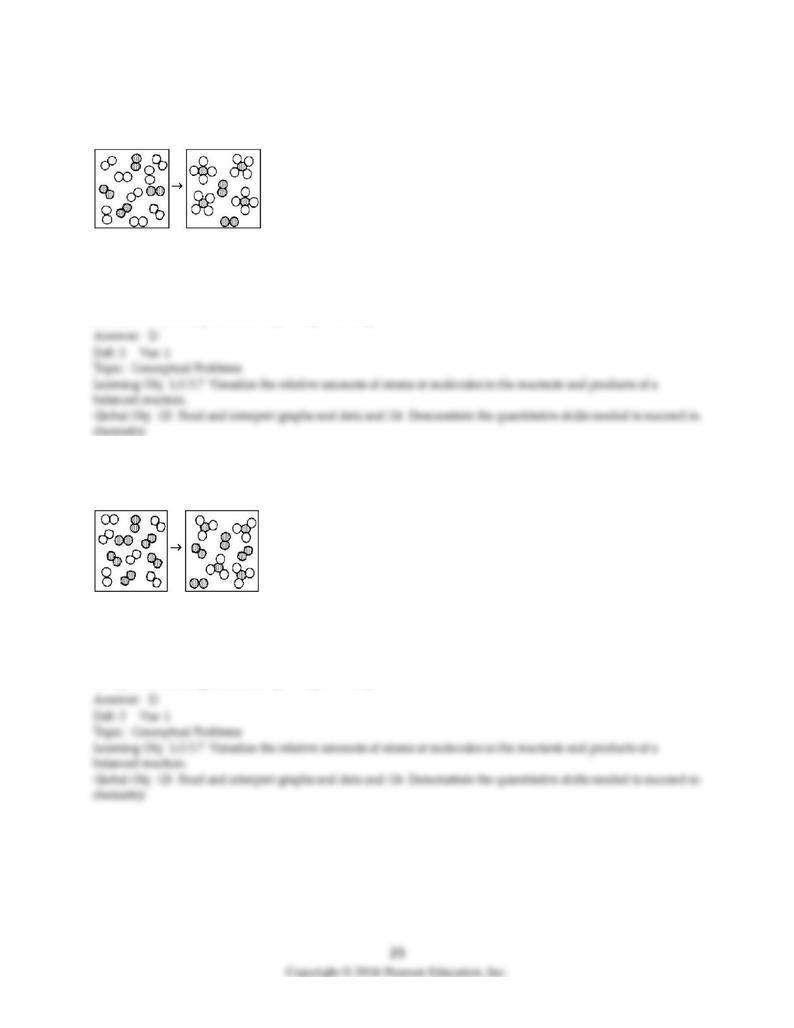
74) The following diagrams represent the reaction of A2 (shaded spheres) with B2 (unshaded spheres).
Identify the limiting reactant and write a balanced equation for the reaction.
A) A2 is the limiting reactant; A + 4 B → AB4.
B) A2 is the limiting reactant; A2 + 4 B2 → 2 AB4.
C) B2 is the limiting reactant; A + 4 B → AB4.
D) B2 is the limiting reactant; A2 + 4 B2 → 2 AB4.
75) The following diagrams represent the reaction of A2 (shaded spheres) with B2 (unshaded spheres).
Identify the limiting reactant and write a balanced equation for the reaction.
A) A2 is the limiting reactant; A + 3 B → AB3.
B) A2 is the limiting reactant; A2 + 3 B2 → 2 AB3.
C) B2 is the limiting reactant; A + 3 B → AB3.
D) B2 is the limiting reactant; A2 + 3 B2 → 2 AB3.
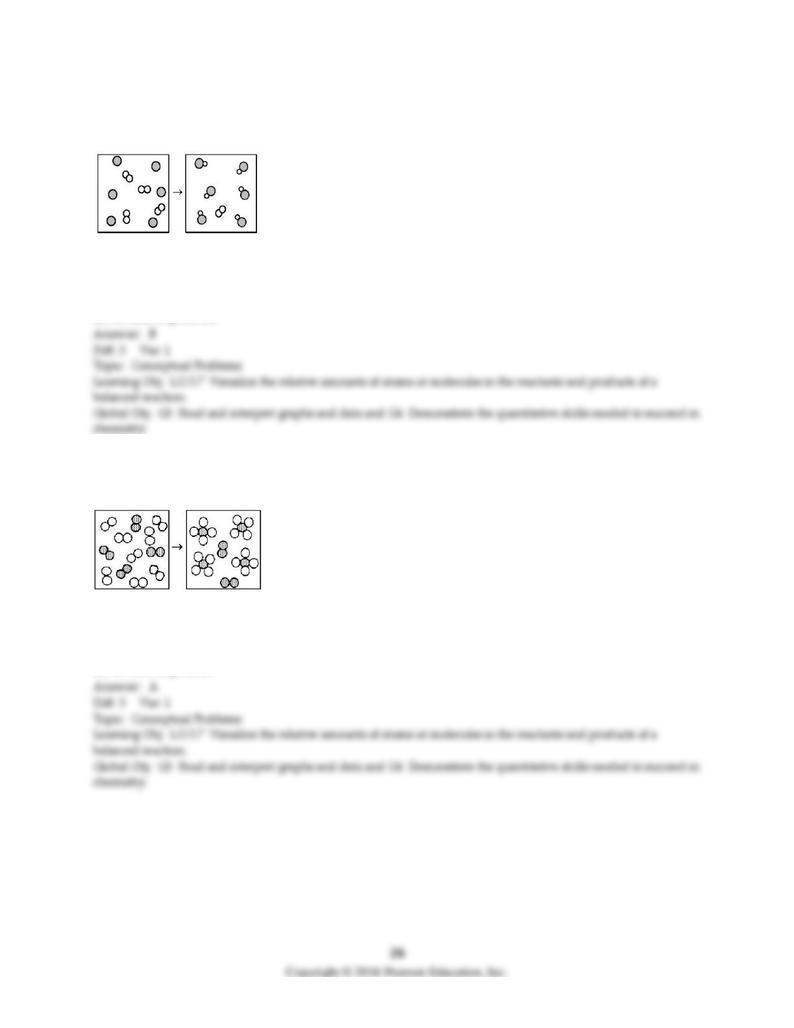
76) The following diagram represents the reaction of A2 (unshaded spheres) with B (shaded spheres).
How many moles of product can be produced from the reaction of 1.0 mol of A2 and 1.0 mol of B?
A) 0.5 mol of product
B) 1.0 mol of product
C) 3.0 mol of product
D) 6.0 mol of product
77) The following diagram represents the reaction of A2 (unshaded spheres) with B2 (shaded spheres).
How many moles of product can be produced from the reaction of 1.0 mol of A2 and 1.0 mol of B2?
A) 0.5 mol of product
B) 1.0 mol of product
C) 2.0 mol of product
D) 4.0 mol of product
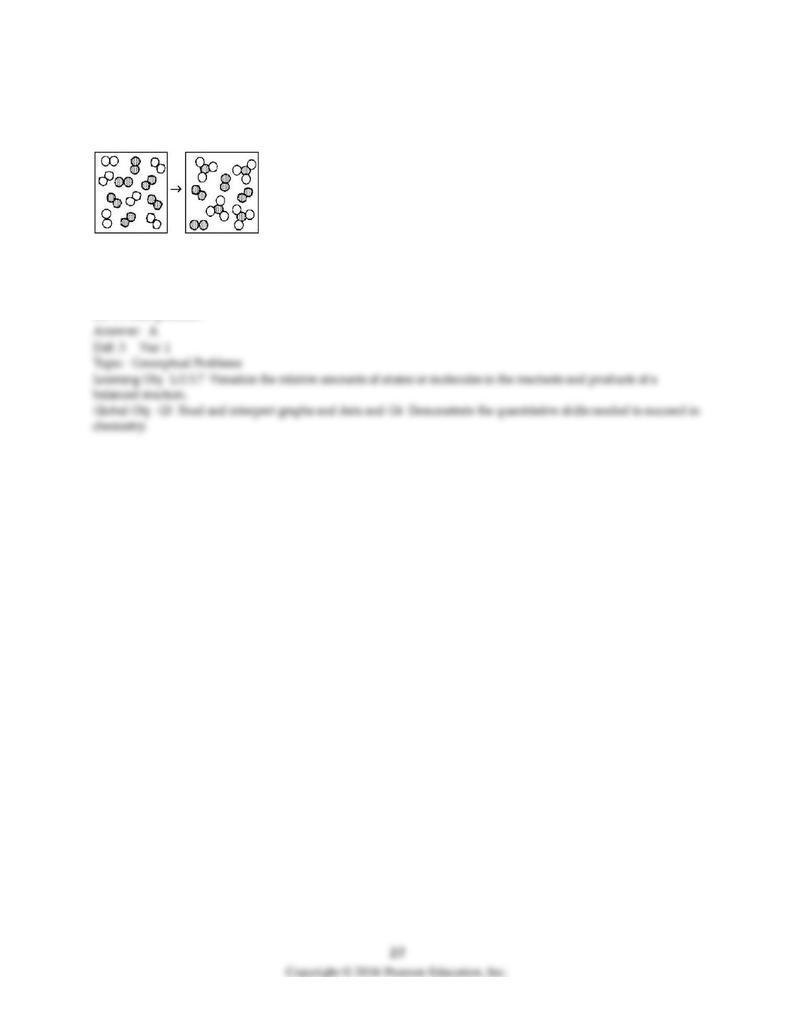
78) The following diagrams represent the reaction of A2 (shaded spheres) with B2 (unshaded spheres).
How many moles of product can be made from 1.0 mol of A2 and 1.0 mol of B2?
A) 0.67 mol product
B) 1.0 mol product
C) 2.0 mol product
D) 3.0 mol product
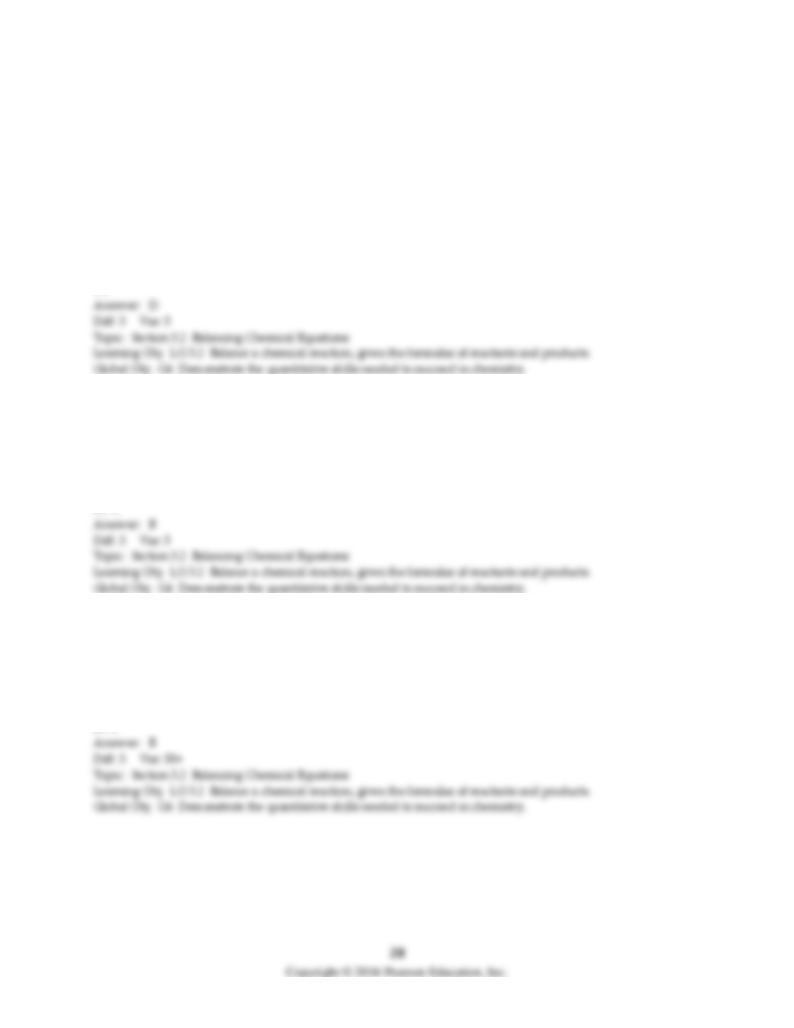
3.2 Algorithmic Questions
1) What is the stoichiometric coefficient for oxygen when the following equation is balanced using the
lowest whole-number coefficients?
________ C3H6O2(l) + ________ O2(g) → ________ CO2(g) + ________ H2O(l)
A) 1
B) 3
C) 5
D) 7
2) Aluminum metal reacts with aqueous copper(II) sulfate to form aqueous aluminum sulfate and copper
metal. What is the stoichiometric coefficient for aluminum when the chemical equation is balanced using
the lowest whole-number stoichiometric coefficients?
A) 1
B) 2
C) 3
D) 4
3) Aluminum metal reacts with aqueous iron(II) chloride to form aqueous aluminum chloride and iron
metal. What is the stoichiometric coefficient for iron when the chemical equation is balanced using the
lowest whole-number stoichiometric coefficients?
A) 0
B) 3
C) 5
D) 8
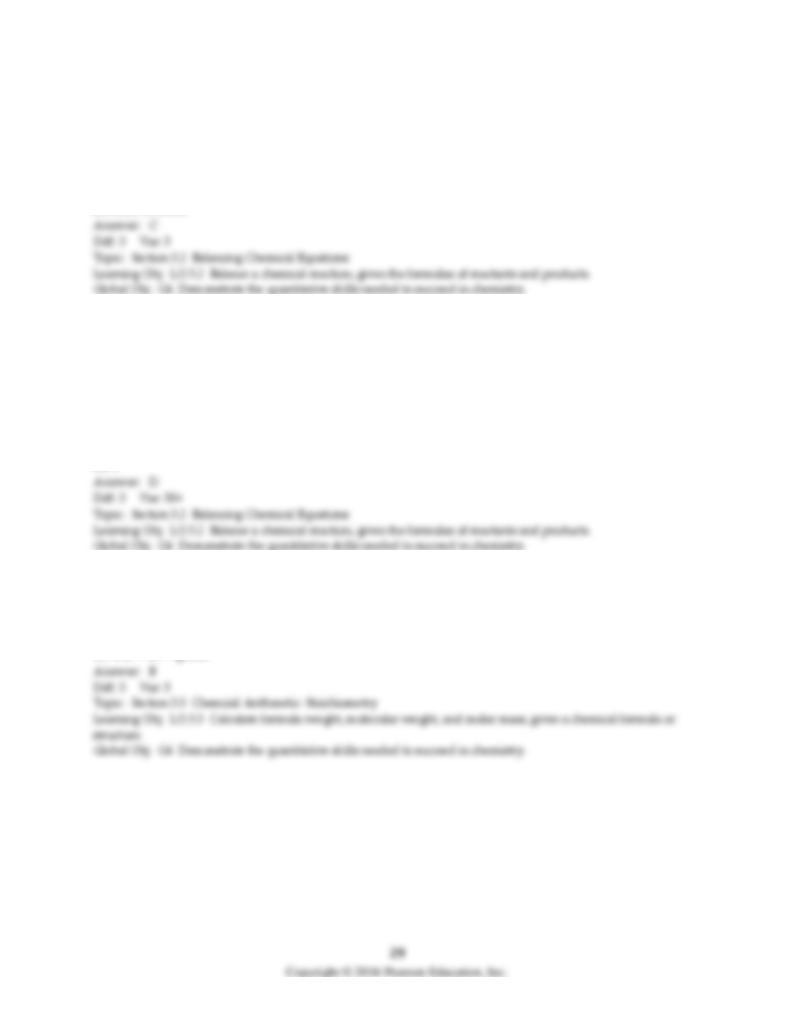
4) Strontium phosphate reacts with sulfuric acid to form strontium sulfate and phosphoric acid. What is
the coefficient for sulfuric acid when the equation is balanced using the lowest whole-numbered
coefficients?
A) 1
B) 2
C) 3
D) none of these
5) What is the stoichiometric coefficient for water when the following equation is balanced using the
lowest whole-number coefficients?
________ C3H8O(l) + ________ O2(g) → ________ CO2(g) + ________ H2O(l)
A) 3
B) 7
C) 6
D) 8
6) What is the molar mass of nitrogen gas?
A) 14.0 g/mol
B) 28.0 g/mol
C) 6.02 × 1023 g/mol
D) 1.20 × 1023 g/mol
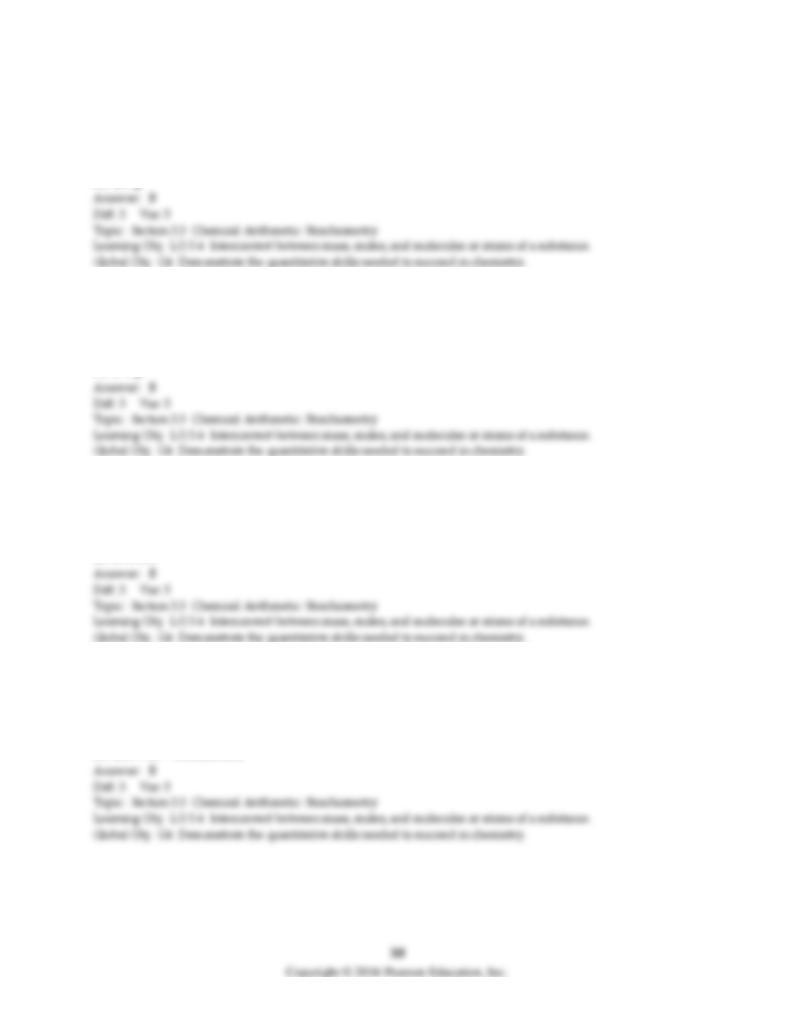
7) What is the mass of a single astatine molecule, At2?
A) 3.49 × 10-22 g
B) 6.97 × 10-22 g
C) 210 g
D) 420 g
8) What is the mass of 0.500 mol of carbon tetrafluoride, CF4?
A) 5.68 × 10-3 g
B) 44.0 g
C) 88.0 g
D) 176 g
9) How many moles are there in 4.00 g of ethanol, CH3CH2OH?
A) 0.00543 mol
B) 0.0870 mol
C) 11.5 mol
D) 184 mol
10) How many Fe(II) ions are there in 5.00 g of FeSO4?
A) 5.46 × 10-26 iron(II) ions
B) 1.98 × 1022 iron(II) ions
C) 1.83 × 1025 iron(II) ions
D) 4.58 × 1026 iron(II) ions
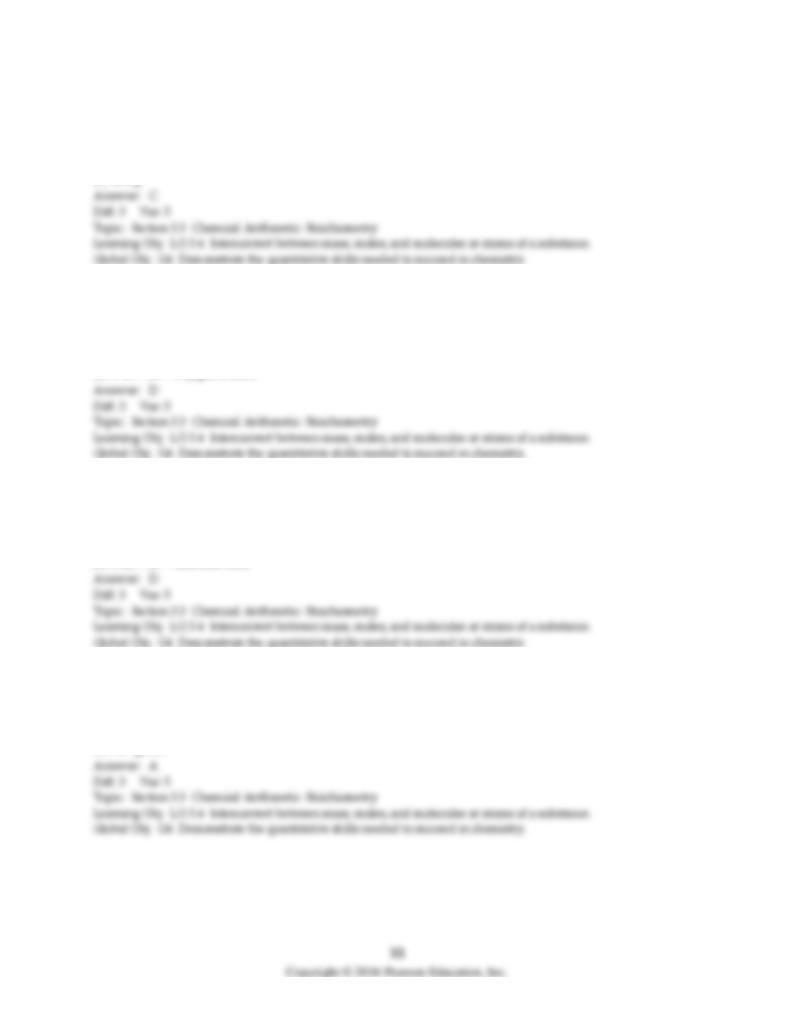
11) What is the mass of 9.00 × 1022 molecules of NH3?
A) 0.00878 g
B) 0.393 g
C) 2.55 g
D) 114 g
12) How many oxygen atoms are there in 6.00 g of sodium dichromate, Na2Cr2O7?
A) 0.160 oxygen atoms
B) 1.97 × 1021 oxygen atoms
C) 1.37 × 1022 oxygen atoms
D) 9.65 × 1022 oxygen atoms
13) How many chloride ions are there in 3.00 mol of aluminum chloride?
A) 3.00 chloride ions
B) 9.00 chloride ions
C) 1.81 × 1024 chloride ions
D) 5.42 × 1024 chloride ions
14) What is the molar mass of pentane if 4.18 × 1016 molecules of pentane weigh 5.00 μg?
A) 72.0 g/mol
B) 139 g/mol
C) 288 g/mol
D) 347 g/mol

15) What mass of ammonia, N H3, contains the same number of molecules as 3.00 g of
trichlorofluoromethane, CCl3F?
A) 0.0412 g
B) 0.371 g
C) 2.69 g
D) 24.2 g
16) What mass of sulfur hexafluoride, SF6, has the same number of fluorine atoms as 25.0 g of oxygen
difluoride, OF2?
A) 0.901 g
B) 8.33 g
C) 22.5 g
D) 203 g
17) How many anions are there in 4.50 g of MgBr2?
A) 1.47 × 1022 anions
B) 2.94 × 1022 anions
C) 2.46 × 1025 anions
D) 4.93 × 1025 anions
18) How many cations are there in 50.0 g of sodium phosphate?
A) 1.84 × 1023 cations
B) 5.51 × 1023 cations
C) 1.97 × 1024 cations
D) 5.92 × 1024 cations
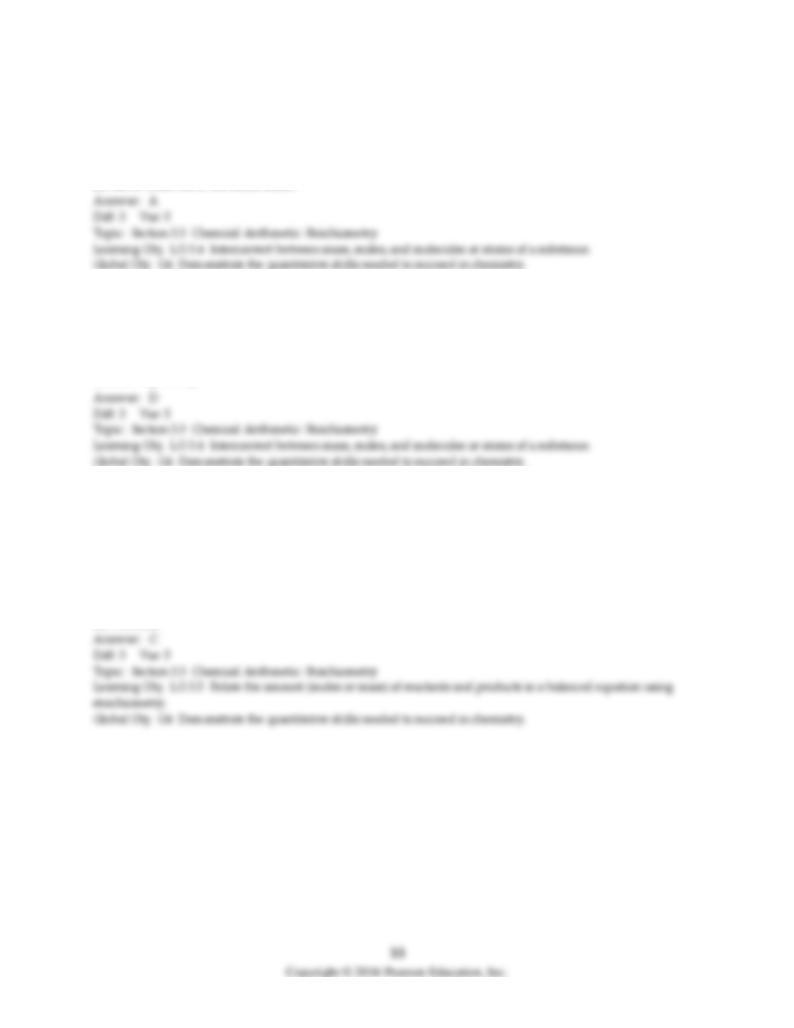
19) Which of the following has the greatest mass?
A) 1.55 × 1023 molecules of O2
B) 4.00 g of O2
C) 0.125 mol of O2
D) All of these have the same mass.
20) Which of the following has the smallest mass?
A) 1.40 × 1024 molecules of I2
B) 340. g of Cl2
C) 10.0 mol of F2
D) 0.200 kg of Br2
21) How many moles of CuO can be produced from 1.80 mol of Cu2O in the following reaction?
2 Cu2O(s) + O2(g) → 4 CuO(s)
A) 0.900 mol
B) 1.80 mol
C) 3.60 mol
D) 7.20 mol
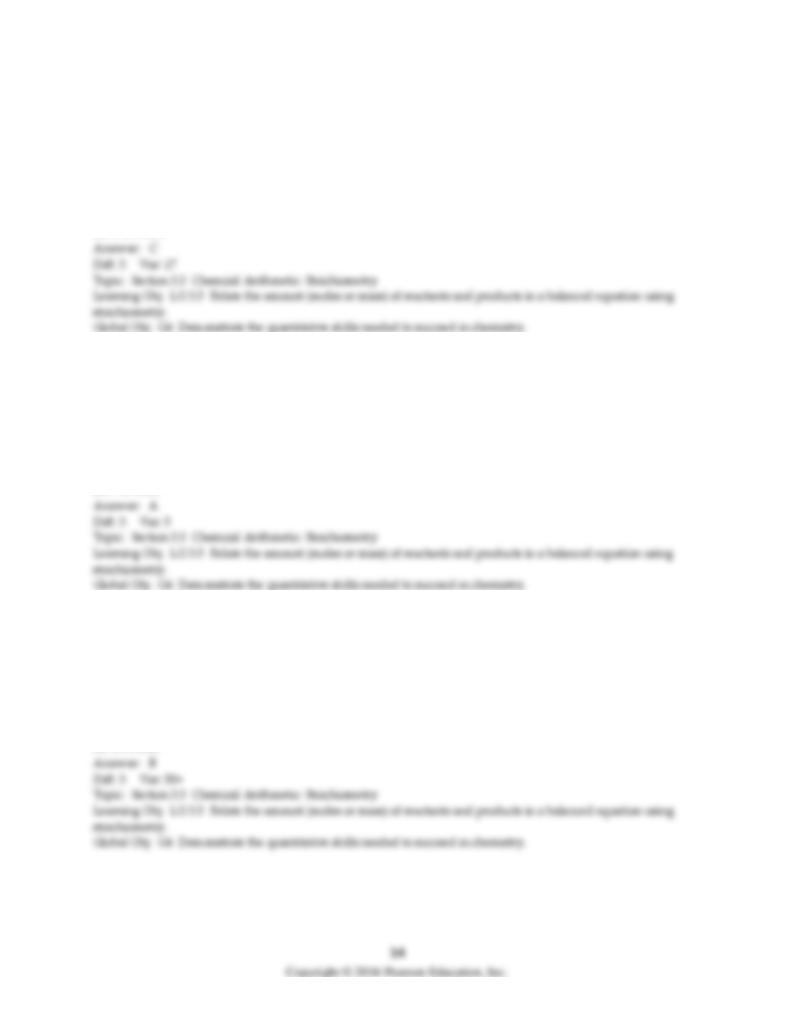
22) How many moles of O2 react with 3.600 mol of Cu2O in the following reaction?
2 Cu2O(s) + O2(g) → 4 CuO(s)
A) 7.200 mol
B) 3.600 mol
C) 1.800 mol
D) 5.400 mol
23) How many moles of BCl3 are needed to produce 15.0 g of HCl(aq) in the following reaction?
BCl3(g) + 3 H2O(l) → 3 HCl(aq) + B(OH)3(aq)
A) 0.137 mol
B) 0.411 mol
C) 1.23 mol
D) 7.29 mol
24) How many moles of H2O are needed to produce 15.0 g of HCl(aq) in the following reaction?
BCl3(g) + 3 H2O(l) → 3 HCl(aq) + B(OH)3(aq)
A) 0.412 mol
B) 0.137 mol
C) 5.0 mol
D) 35.0 mol
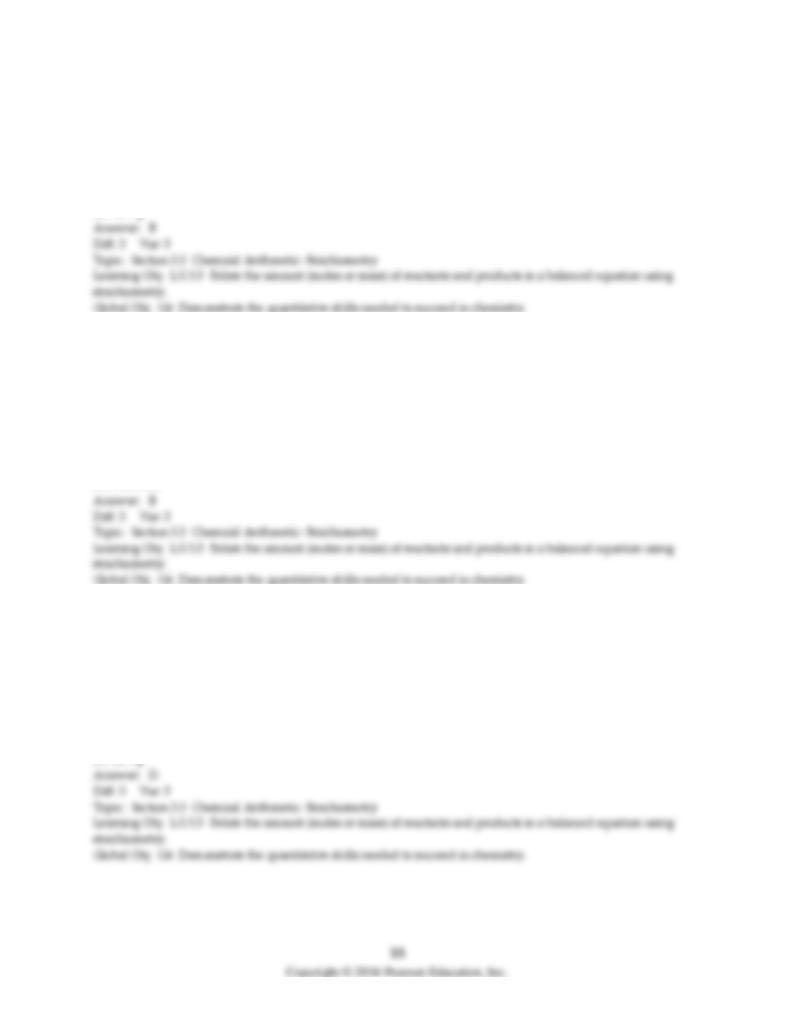
25) How many grams of calcium chloride are needed to produce 5.00 g of potassium chloride?
CaCl2(aq) + K2CO3(aq) → 2 KCl(aq) + CaCO3(aq)
A) 0.269 g
B) 3.72 g
C) 7.44 g
D) 14.9 g
26) Balance the chemical equation given below, and determine the number of moles of iodine that reacts
with 10.0 g of aluminum.
________ Al(s) + ________ I2(s) → ________ Al2I6(s)
A) 0.247 mol
B) 0.556 mol
C) 0.741 mol
D) 1.11 mol
27) Balance the chemical equation given below, and determine the number of grams of MgO are needed
to produce 25.0 g of Fe2O3.
________ MgO(s) + ________ Fe(s) → ________ Fe2O3(s) + ________ Mg(s)
A) 0.0528 g
B) 2.10 g
C) 6.31 g
D) 18.9 g
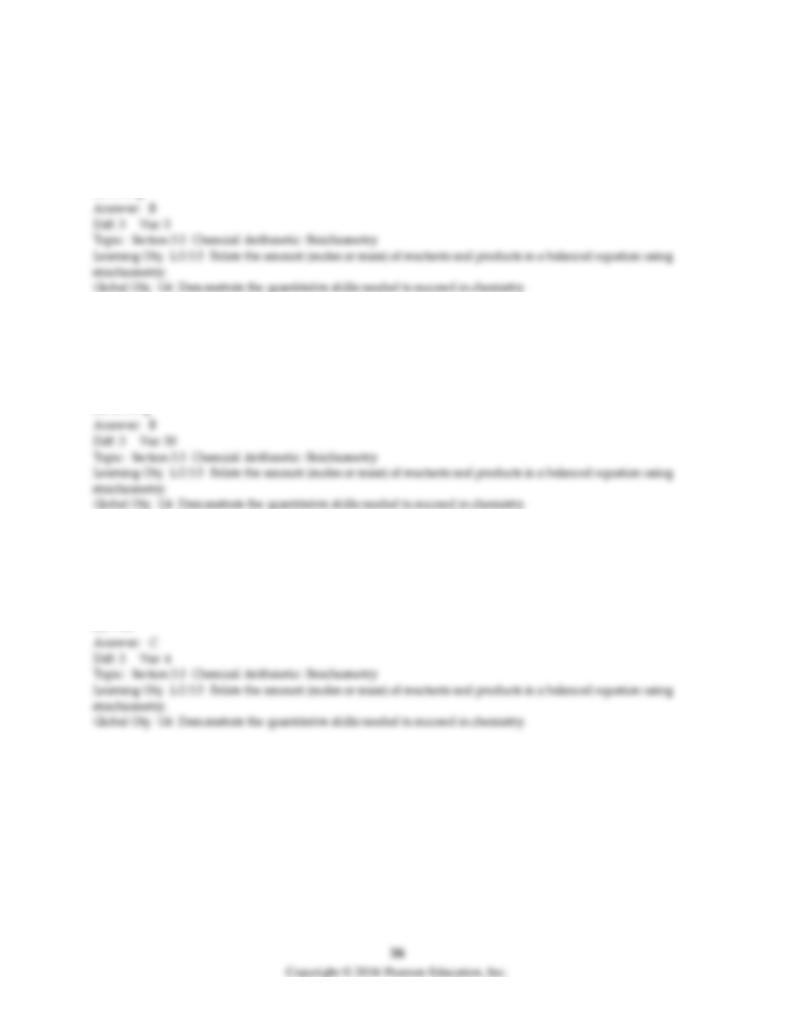
28) Dinitrogen monoxide gas decomposes to form nitrogen gas and oxygen gas. How many grams of
oxygen are formed when 20.0 g of dinitrogen monoxide decomposes?
A) 0.138 g
B) 7.27 g
C) 14.5 g
D) 29.1 g
29) Dinitrogen monoxide gas decomposes to form nitrogen gas and oxygen gas. How many grams of
nitrogen are formed when 30.00 g of dinitrogen monoxide decomposes?
A) 9.545 g
B) 19.09 g
C) 30.00 g
D) 60.00 g
30) Dinitrogen monoxide gas decomposes to form nitrogen gas and oxygen gas. How many grams of
nitrogen are formed when 5.54 g of dintrogen monoxide decomposes?
A) 4.35
B) 17.41
C) 3.53
D) 7.06
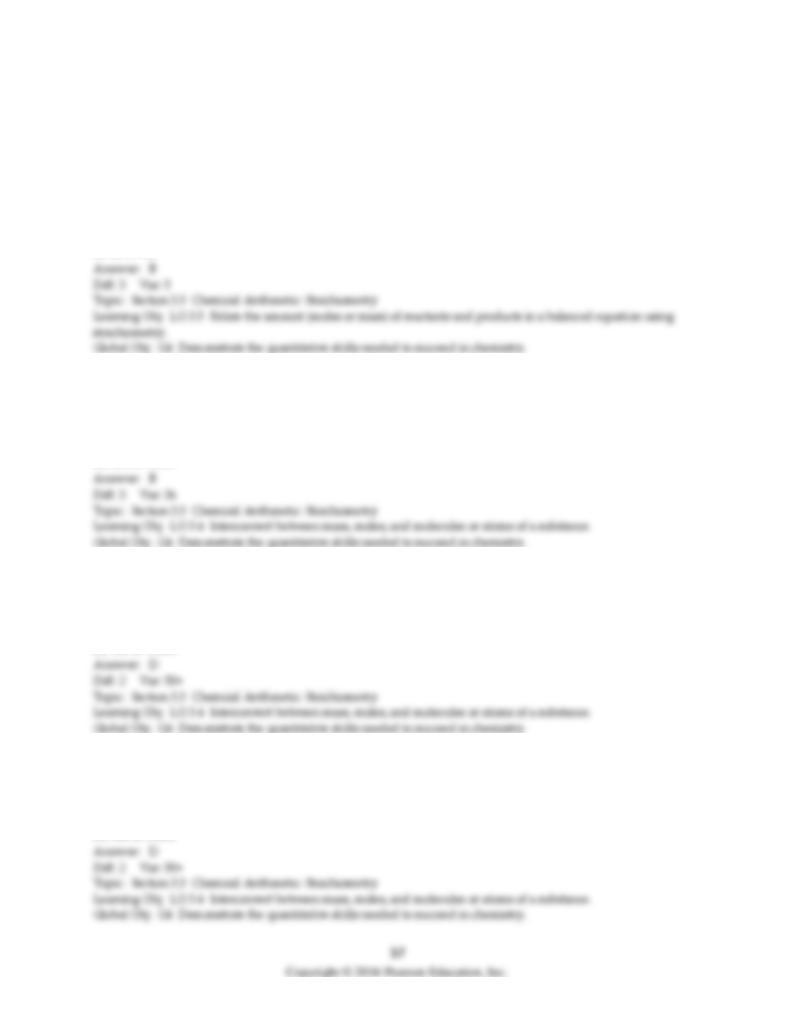
31) If the density of ethanol, C2H5OH, is 0.789 g/mL. How many milliliters of ethanol are needed to
produce 10.0 g of CO2 according to the following chemical equation?
C2H5OH(l) + 3 O2(g) → 2 CO2(g) + 3 H2O(l)
A) 4.13 mL
B) 6.63 mL
C) 13.3 mL
D) 26.5 mL
32) 1.00 mole of O2 contains the same number of molecules as
A) 0.667 mole of O3.
B) 1.00 mole of CH3CO2CH2Cl.
C) 2.00 mole of CH3CH2OCH2Br.
D) All of these
33) Which represents one formula unit?
A) One Cu
B) One F2
C) One NaH
D) All of these
34) Identify one mole of a substance.
A) 32.0 grams of H2
B) 52.0 grams of Cr
C) 8.0 grams of LiH
D) All of these
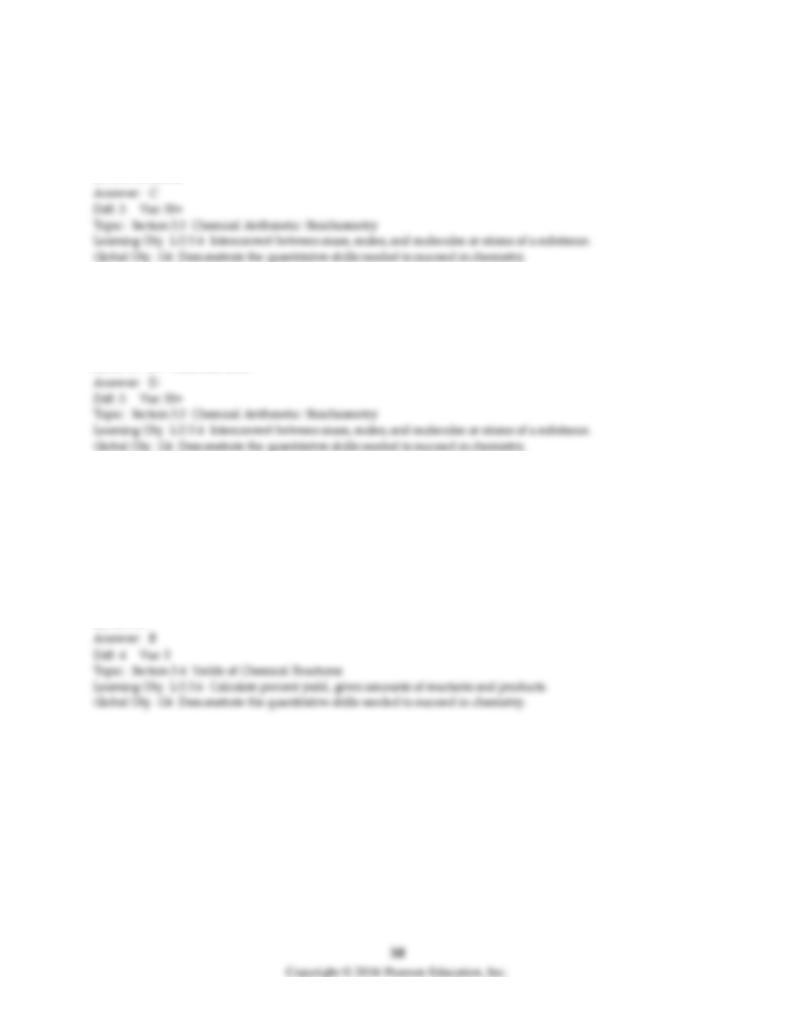
35) What is the number of moles of 5.00 × 1022 molecules of NaBr?
A) 0.037 moles
B) 1.0 moles
C) 0.083 moles
D) 1.2046 moles
36) How many chloride ions are in 1.50 mol of aluminum chloride?
A) 2.00 chloride ions
B) 2.009.023 chloride ions
C) 9.023 × 1023 chloride ions
D) 2.71 × 1024 chloride ions
37) When 14.0 g of calcium metal is reacted with water, 5.00 g of calcium hydroxide is produced. Using
the following balanced equation, calculate the percent yield for the reaction?
Ca(s) + 2 H2O(l) → Ca(OH)2(aq) + H2(g)
A) 9.67%
B) 19.3%
C) 35.7%
D) 66.0%
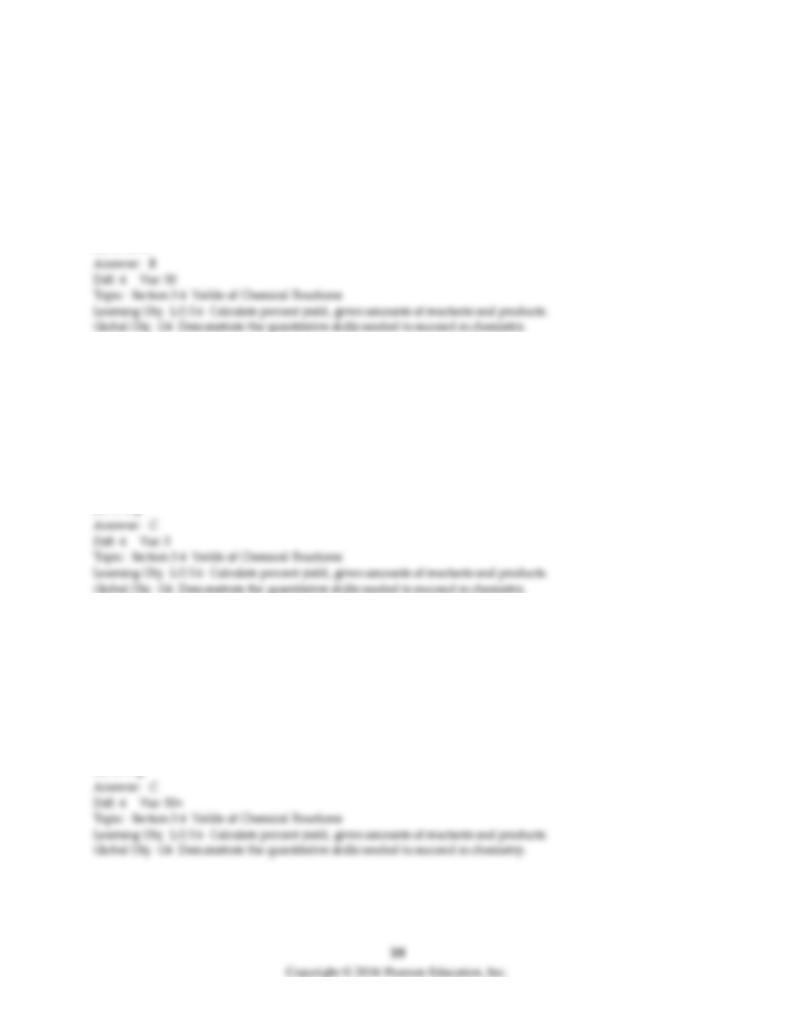
38) When 12.00 g of calcium metal is reacted with water, 12.00 g of calcium hydroxide is produced. Using
the following balanced equation, calculate the percent yield for the reaction?
Ca(s) + 2 H2O(l) → Ca(OH)2(aq) + H2(g)
A) 27.02%
B) 54.05%
C) 100.0%
D) 30.00%
39) If the percent yield for the following reaction is 65.0%, how many grams of KClO3 are needed to
produce 42.0 g of O2?
2 KClO3(s) → 2 KCl(s) + 3 O2(g)
A) 69.7 g
B) 107 g
C) 165 g
D) 371 g
40) If the percent yield for the following reaction is 80.0%, how many grams of KClO3 are needed to
produce 42.0 g of O2?
2 KClO3(s) → 2 KCl(s) + 3 O2(g)
A) 10.5 g
B) 62.5 g
C) 134 g
D) 63.0 g
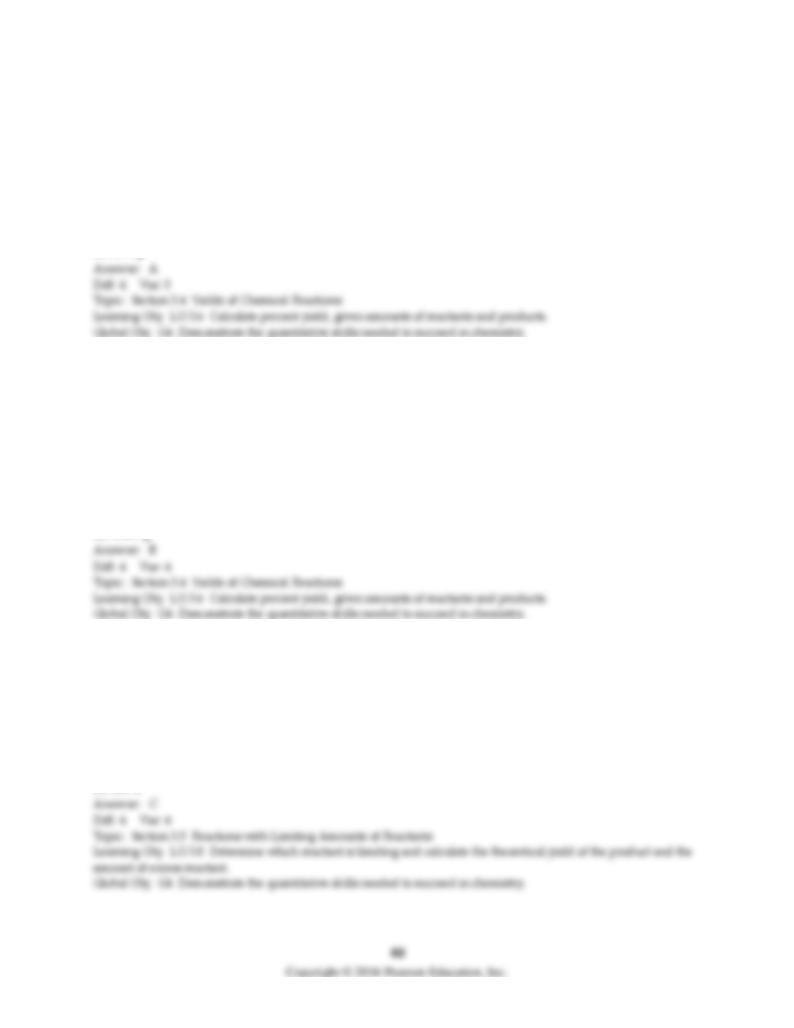
41) If the percent yield for the following reaction is 75.0%, and 35.0 g of NO2 are consumed in the
reaction, how many grams of nitric acid, HNO3(aq) are produced?
3 NO2(g) + H2O(l) → 2 HNO3(aq) + NO(g)
A) 24.0 g
B) 31.9 g
C) 42.6 g
D) 53.9 g
42) Hydrazine, N2H4, once used as a rocket propellant, reacts with oxygen in the following equation.
N2H4(g) + O2(g) → N2(g) + 2 H2O(g)
The reaction, at 50% yield, produces 4.0 moles of N2. What was the mass of hydrazine used? Assume
that O2 is in excess.
A) 32.0 g
B) 260 g
C) 64 g
D) 0.063 g
43) Consider the following balanced reaction.
4A + 2B → 2C + D
8.0 moles of A and 30. moles of B react to form 2.5 moles of C. What is the percent yield of this reaction?
A) 10%
B) 62.5%
C) 83%
D) 100%
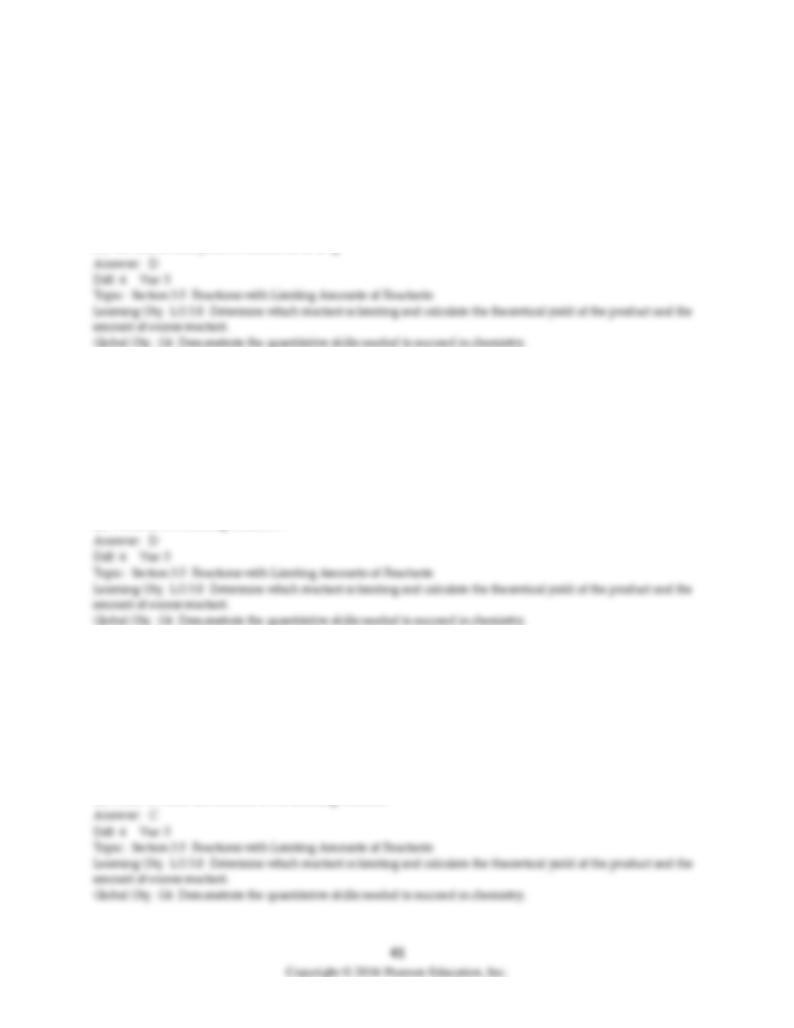
44) 10 g of nitrogen is reacted with 5.0 g of hydrogen to produce ammonia according to the chemical
equation shown below. Which one of the following statements is false?
N2(g) + 3 H2(g) → 2 NH3(g)
A) 2.8 g of hydrogen are left over.
B) Hydrogen is the excess reactant.
C) Nitrogen is the limiting reactant.
D) The theoretical yield of ammonia is 15 g.
45) 9.0 g of iron is reacted with 9.0 g of water according to the chemical equation shown below. Which
one of the following statements is false?
3 Fe(s) + 4 H2O(l) → Fe3O4(s) + 4 H2(g)
A) 12.4 g of Fe3O4 are produced.
B) 5.13 g of H2O are left over.
C) Mass is conserved in this reaction.
D) Water is the limiting reactant.
46) Which substance is the limiting reactant when 8.0 g of sulfur reacts with 12 g of oxygen and 16 g of
sodium hydroxide according to the following chemical equation?
2 S(s) + 3 O2(g) + 4 NaOH(aq) → 2 Na2SO4(aq) + 2 H2O(l)
A) S(s)
B) O2(g)
C) NaOH(aq)
D) None of these substances is the limiting reactant.
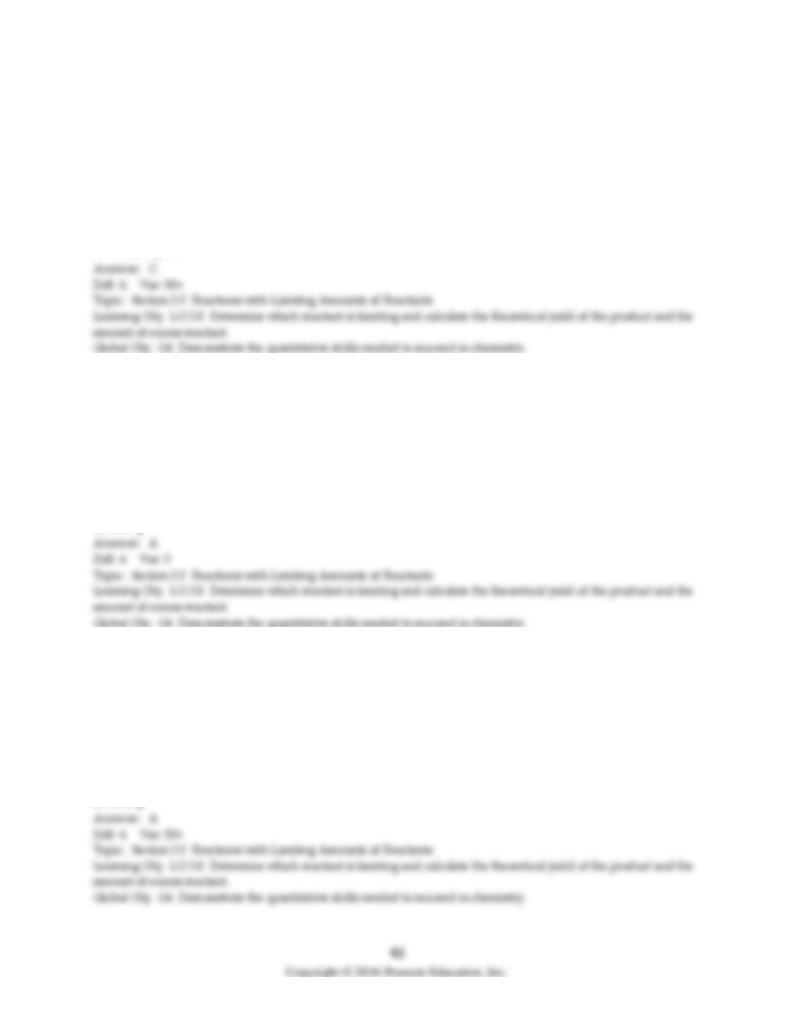
47) Which substance is the limiting reactant when 16.0 g of sulfur reacts with 10.0 g of oxygen and 12.0 g
of sodium hydroxide according to the following chemical equation?
2 S(s) + 3 O2(g) + 4 NaOH(aq) → 2 Na2SO4(aq) + 2 H2O(l)
A) S(s)
B) O2(g)
C) NaOH (aq)
D) Na2SO4(aq)
48) When 5.00 × 1022 molecules of ammonia react with 4.00 × 1022 molecules of oxygen according to the
chemical equation shown below, how many grams of nitrogen gas are produced?
4 NH3(g) + 3 O2(g) → 2 N2(g) + 6 H2O(g)
A) 1.16 g
B) 1.24 g
C) 2.79 g
D) 4.65 g
49) When 1.00 × 1022 molecules of ammonia react with 7.00 × 1022 molecules of oxygen according to the
chemical equation shown below, how many grams of nitrogen gas are produced?
4 NH3(g) + 3 O2(g) → 2 N2(g) + 6 H2O(g)
A) 0.232 g
B) 2.17 g
C) 0.464 g
D) 1.86 g
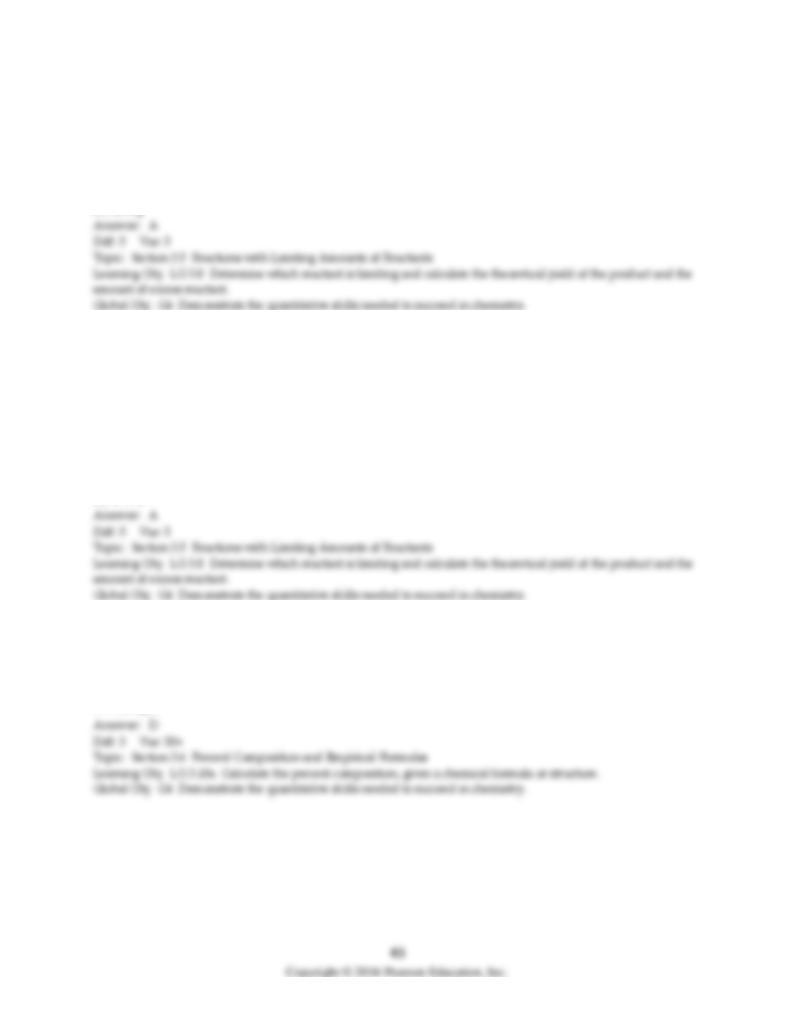
50) When silver nitrate reacts with barium chloride, silver chloride and barium nitrate are formed. How
many grams of silver chloride are formed when 10.8 g of silver nitrate reacts with 15.0 g of barium
chloride?
A) 9.11 g
B) 9.40 g
C) 12.9 g
D) 18.8 g
51) Balance the chemical equation given below, and calculate the volume of nitrogen monoxide gas
produced when 8.00 g of ammonia is reacted with 9.00 g of oxygen at 25°C? The density of nitrogen
monoxide at 25°C is 1.23 g/L.
________ NH3(g) + ________ O2(g) → ________ NO(g) + ________ H2O(l)
A) 5.49 L
B) 8.31 L
C) 11.5 L
D) 17.3 L
52) Which one of the following compounds contains the smallest percent oxygen by mass?
A) CO2
B) N2O4
C) P10O5
D) C9H20O
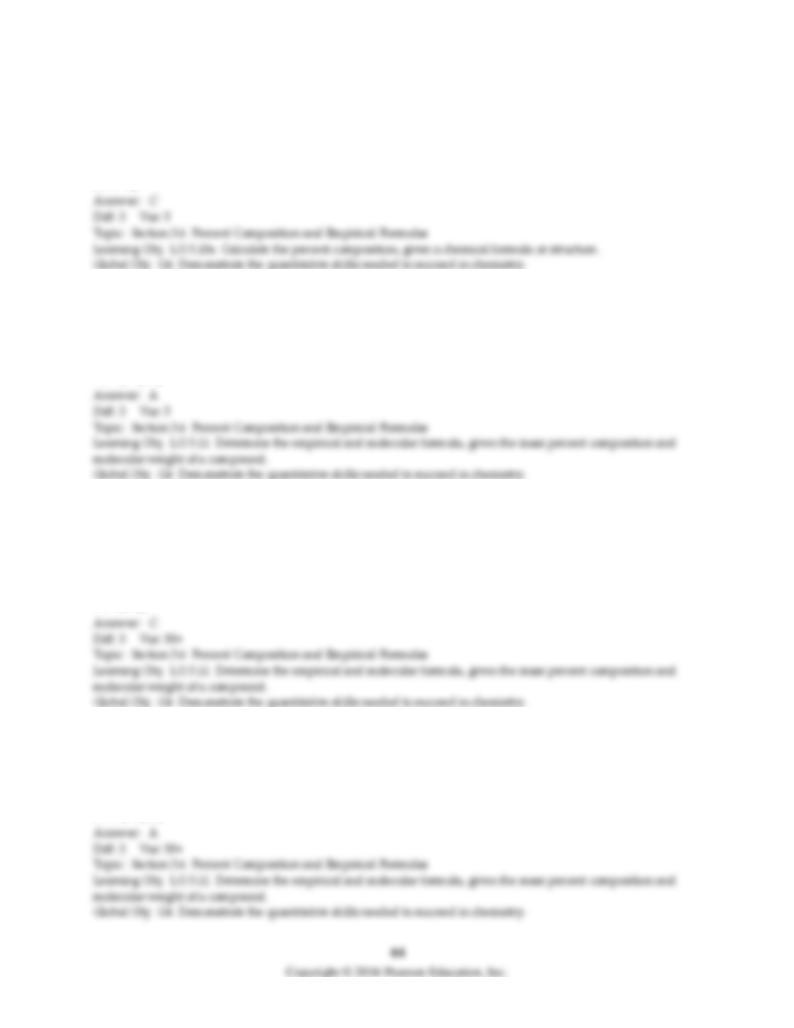
53) Which one of the following contains 52% carbon by mass?
A) C2H2
B) CH4
C) CH3OCH3
D) CO2
54) What is the empirical formula of a substance that contains 2.64 g of C, 0.444 g of H, and 3.52 g of O?
A) CH2O
B) C2H4O2
C) C2H4O3
D) C3H4O4
55) What is the empirical formula for perfluoropropane if the compound contains 81% fluorine and 19%
carbon by mass?
A) CF3
B) C2F4
C) C3F8
D) C6F10
56) What is the empirical formula of a substance that contains 12.0 g of C, 2.00 g of H, and 5.33 g of O?
A) C3H6O
B) C15H30O5
C) C3H5O3
D) C3H4O4

57) Which one of the following is not an empirical formula?
A) CHO
B) CH2O
C) C2H4O
D) C2H2O4
58) Which one of the following is not an empirical formula?
A) CHO
B) CH2O
C) C3H6O
D) C8H16O4
59) Which one of the following is an empirical formula?
A) C2F6
B) H2SO2
C) C2H4O2
D) P4O10
60) Combustion analysis of an unknown compound containing only carbon and hydrogen produced
1.1385 g of CO2 and 0.5805 g of H2O. What is the empirical formula of the compound?
A) CH2
B) C2H5
C) C4H10
D) C5H2
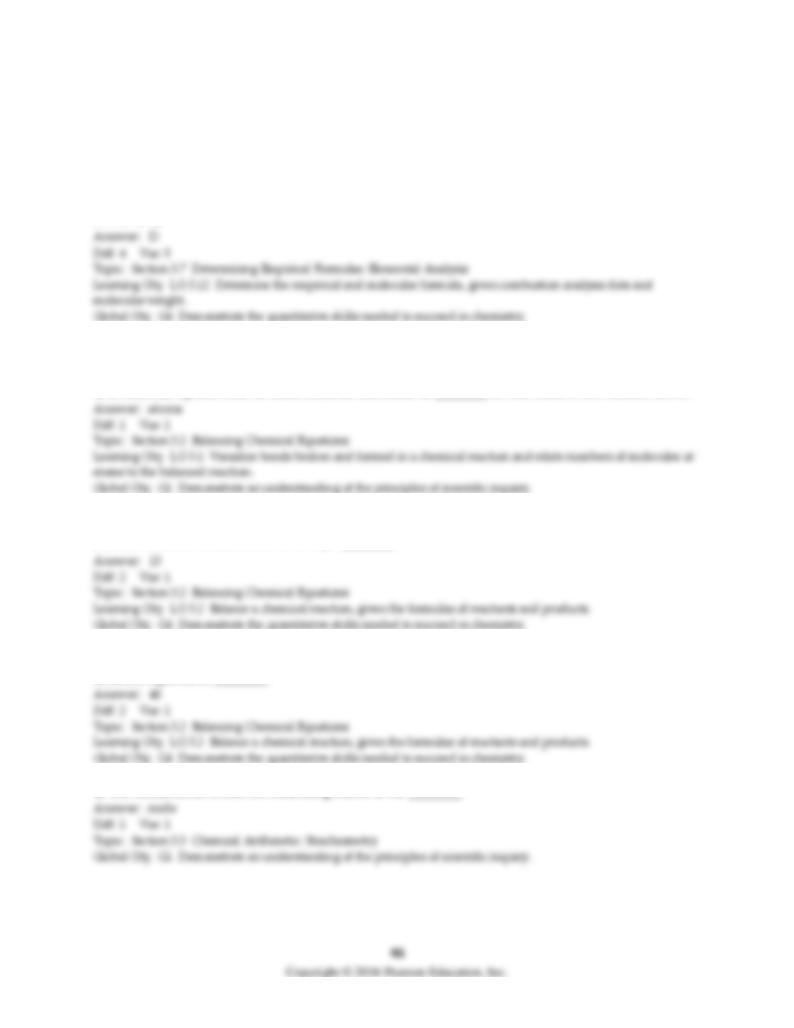
61) Combustion analysis of 0.150 g of an unknown compound containing carbon, hydrogen, and oxygen
produced 0.2607 g of CO2 and 0.1418 g of H2O. What is the empirical formula of the compound?
A) C2H5O
B) C2H5O2
C) C2H10O3
D) C3H8O2
3.3 Short Answer Questions
1) A balanced equation has the same numbers and kinds of ________ on both sides of the reaction arrow.
2) When the reaction C4H10 + O2 → CO2 + H2O is balanced using the smallest whole number
coefficients, the coefficient in front of O2 is ________.
3) When the reaction C3H8 + O2 → CO2 + H2O is balanced, the total number of oxygen atoms in the
balanced equation is ________.
4) The fundamental SI unit for measuring matter is the ________.
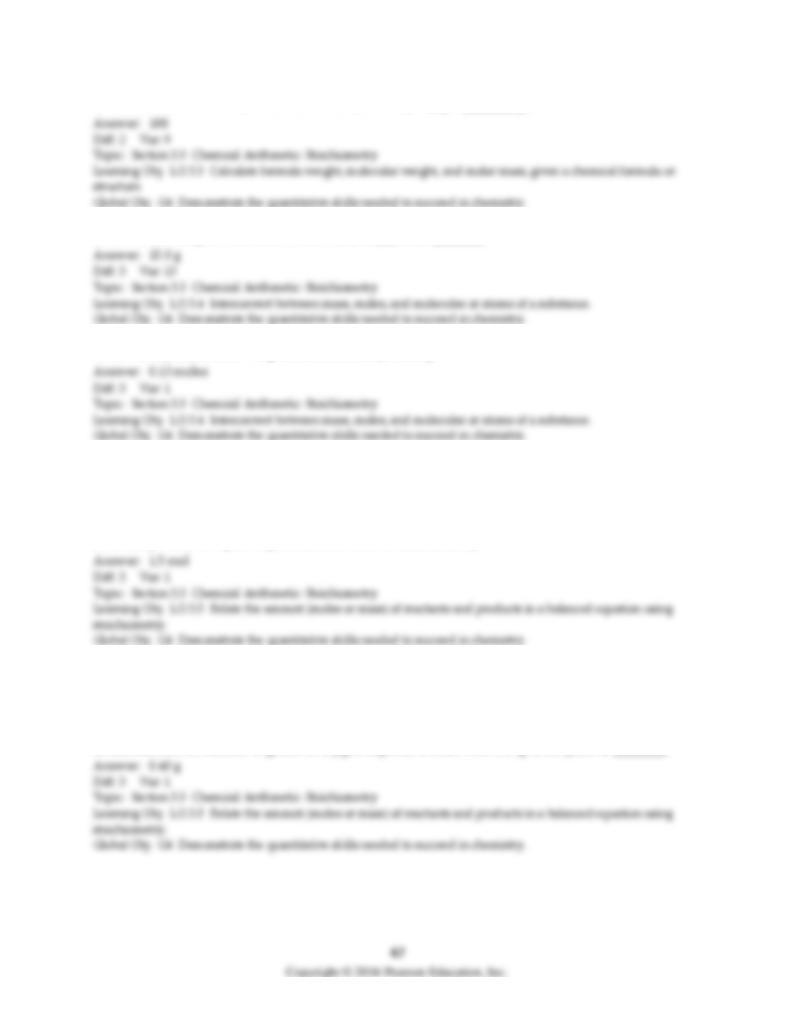
5) To the nearest whole number, the molar mass of Cu(NO3)2 is ________ g/mol.
6) The number of grams in 0.250mol of urea, (NH2)2CO, is ________.
7) How many moles are in 7.8 g of acetamide, CH3CONH2?
8) The balanced equation for the gaseous state oxidation of ammonia is shown below.
4 NH3 + 5 O2 → 4 NO + 6 H2O
How many moles of O2 are required to react with 1.2 mole of NH3?
9) The balanced equation for the reaction of acetylene, C2H2, and oxygen in an acetylene torch is
2 C2H2 + 5 O2 → 4 CO2 + 2 H2O.
In this reaction the number of grams of oxygen required to react with 0.13 g of acetylene is ________.
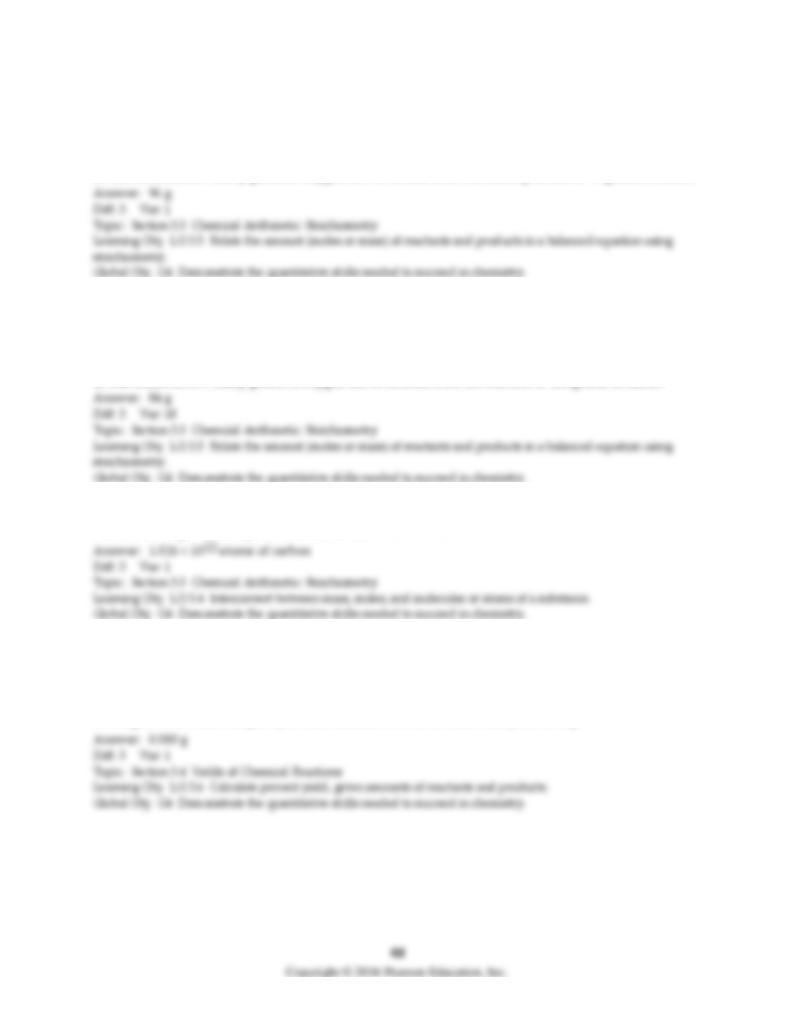
10) Ozone is unstable, decomposing to oxygen, as shown in the balanced equation
2 O3 → 3 O2.
In this reaction, how many grams of oxygen can be formed from the decomposition of 96 grams of ozone?
11) Ozone reacts with iodide ion as shown in the balanced equation below.
O3 + 2 I- + H2O → O2 + I2 + 2 OH-
In this reaction, how many grams of oxygen can be formed from the reaction of 126 grams of ozone?
12) Tablets of ascorbic acid, or Vitamin C, C6H8O6, are taken as a dietary supplement. If a typical tablet
contains 500 mg, how many atoms of carbon (C) are in a tablet?
13) The balanced equation for the decomposition of water is shown below.
2 H2O → 2 H2 + O2
If 0.72 g of water react completely in this reaction, what is the theoretical yield of H2?
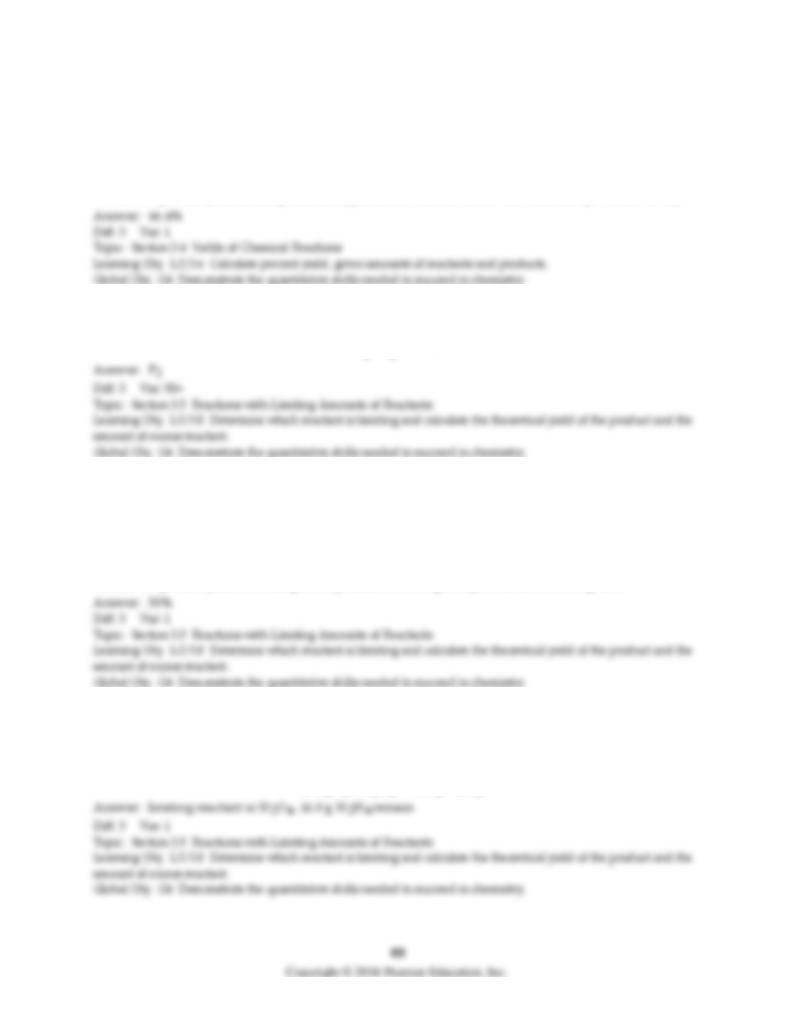
14) Oxygen can be produced from the catalytic decomposition of KClO3 as shown in the balanced
equation below.
2 KClO3 → 2 KCl + 3 O2
What is the percent yield if 3.20 grams of oxygen are formed from the reaction of 12.3 grams of KClO3?
15) If 2.7 g of H2 react with 2.7 g of F2 in the reaction shown below, what is the limiting reactant?
H2 + F2 → 2 HF
16) When carbon dioxide dissolves in water, H+ is formed, which makes the solution acidic, as shown in
the balanced equation below.
CO2 + H2O → HCO3- + H+
What is the percent yield if 0.0088 g of CO2 reacts with 900 g of H2O to form 0.000108 g of H+?
17) Hydrazine, N2H4, is used as a rocket fuel. In the reaction below, if 80.1 g of N2H4 and 92.0 g of N2O4
are allowed to react, which is the limiting reactant, and how many grams of excess reactant remain at the
end of the reaction?
2 N2H4 + N2O4 → 3 N2 + 4 H2O
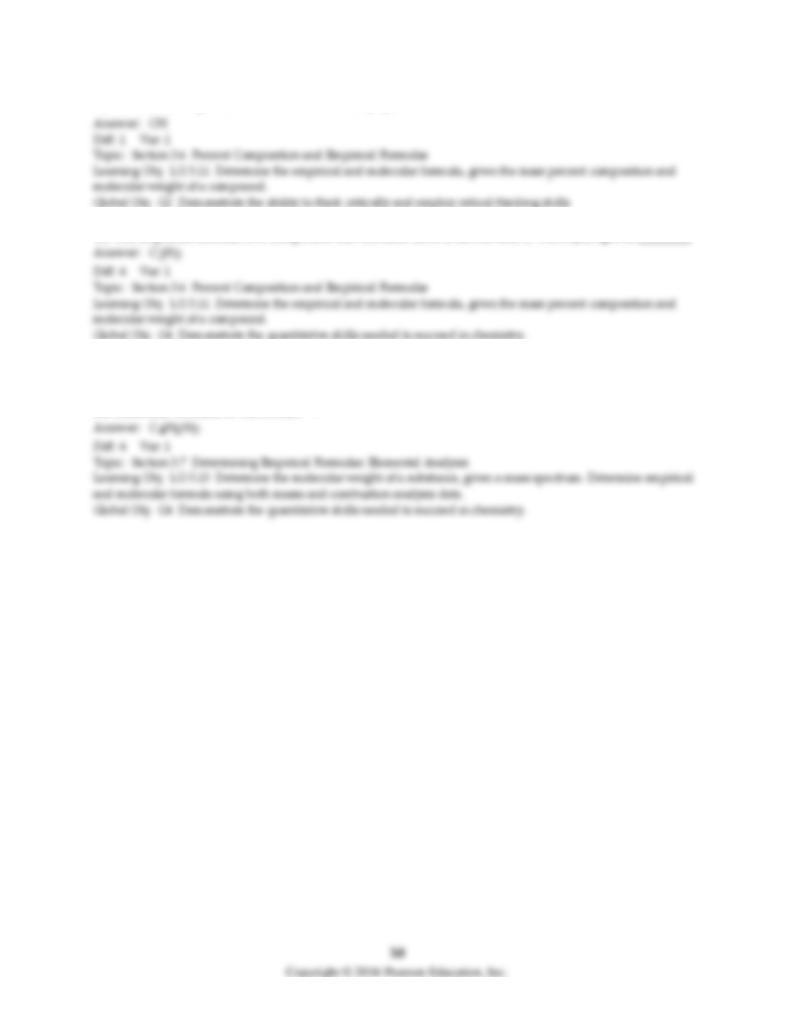
18) What is the empirical formula of benzene, C6H6?
19) The empirical formula of a compound that contains 82.66% carbon and 17.34% hydrogen is ________.
20) Analysis of a 1.000-g sample of the oral hypoglycemic agent metforminTM yielded 0.3720 g of carbon,
0.0858 g of hydrogen, and 0.5422 g of nitrogen. MetforminTM has a molar mass of 129.16 g/mol. What is
the molecular formula of MetforminTM?